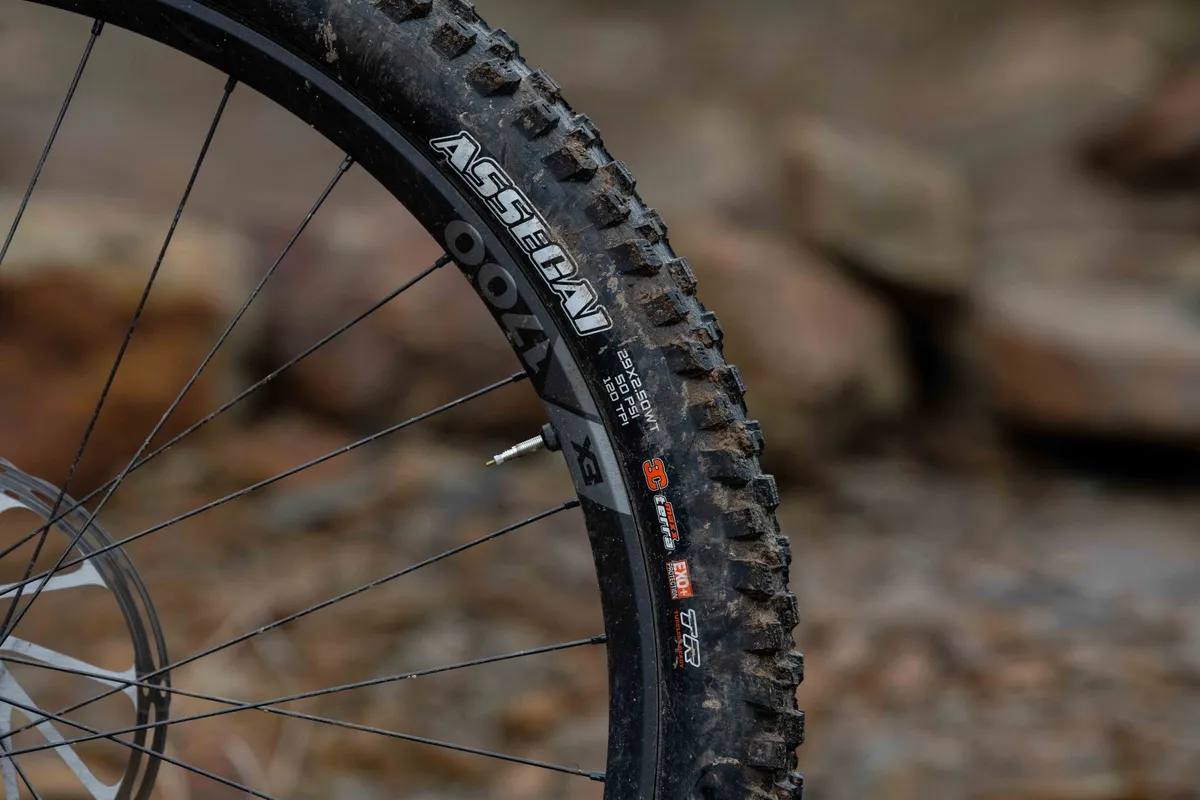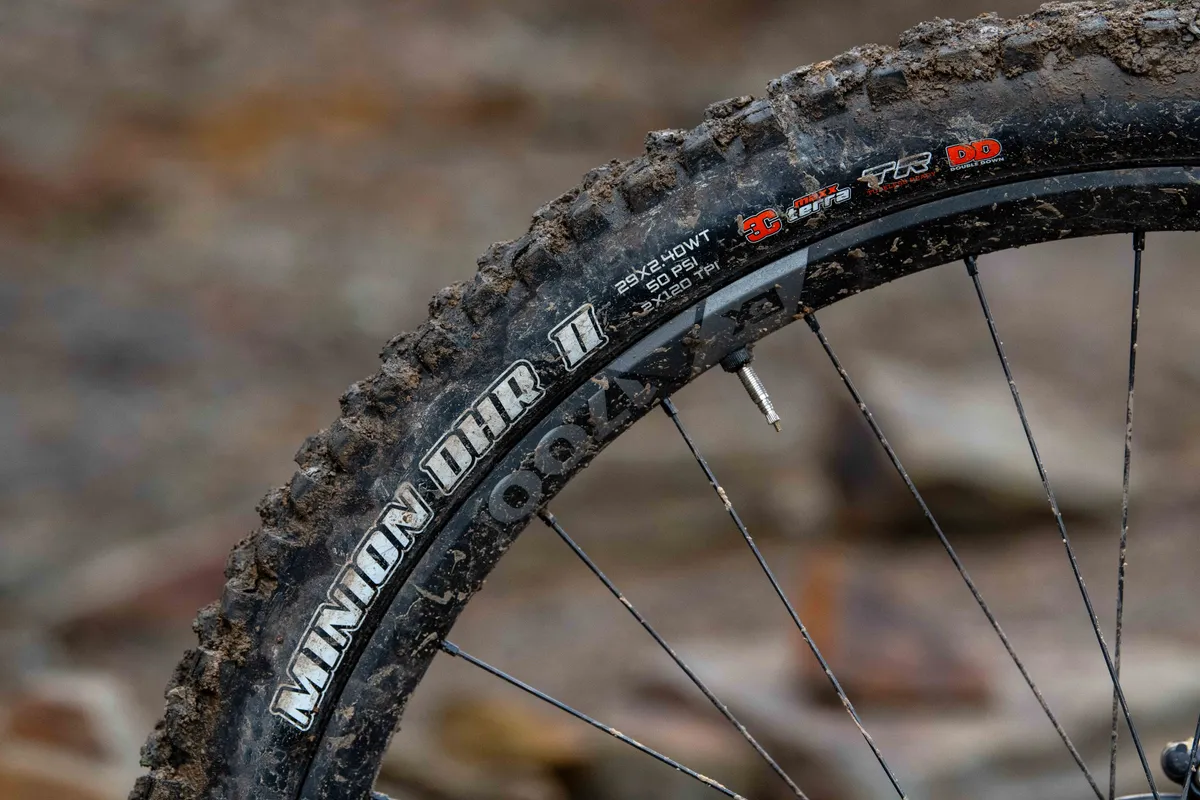Yeti’s 2022 160E is the American brand’s first electric mountain bike and is intended to tackle the electric enduro race segment head-on, having been designed and developed specifically to handle the rigours of the world’s hardest eMTB races.
Of course, that doesn’t mean it can only be used at enduro races, and Yeti argues the bike’s features – including its new six-bar Sixfinity rear-suspension design – will benefit the average rider and racer alike.
With 160mm of super-progressive rear-wheel travel, 29in wheels front and rear, modern mountain bike geometry, and Shimano’s EP-8 85Nm torque motor and 630Wh battery, the Yeti is pitted head-to-head against bikes such as the Specialized S-Works Turbo Levo and the Santa Cruz Bullit CC X01 RSV. It delivers first-class performance in almost all areas.
The top-tier T1 version of the bike has an £11,899 / $12,700 price tag matched with, on the whole, high-spec kit, including a Shimano XT drivetrain. Yeti also offers the 160E in a C1 spec for £9,499 / $10,100 with a Shimano SLX drivetrain.
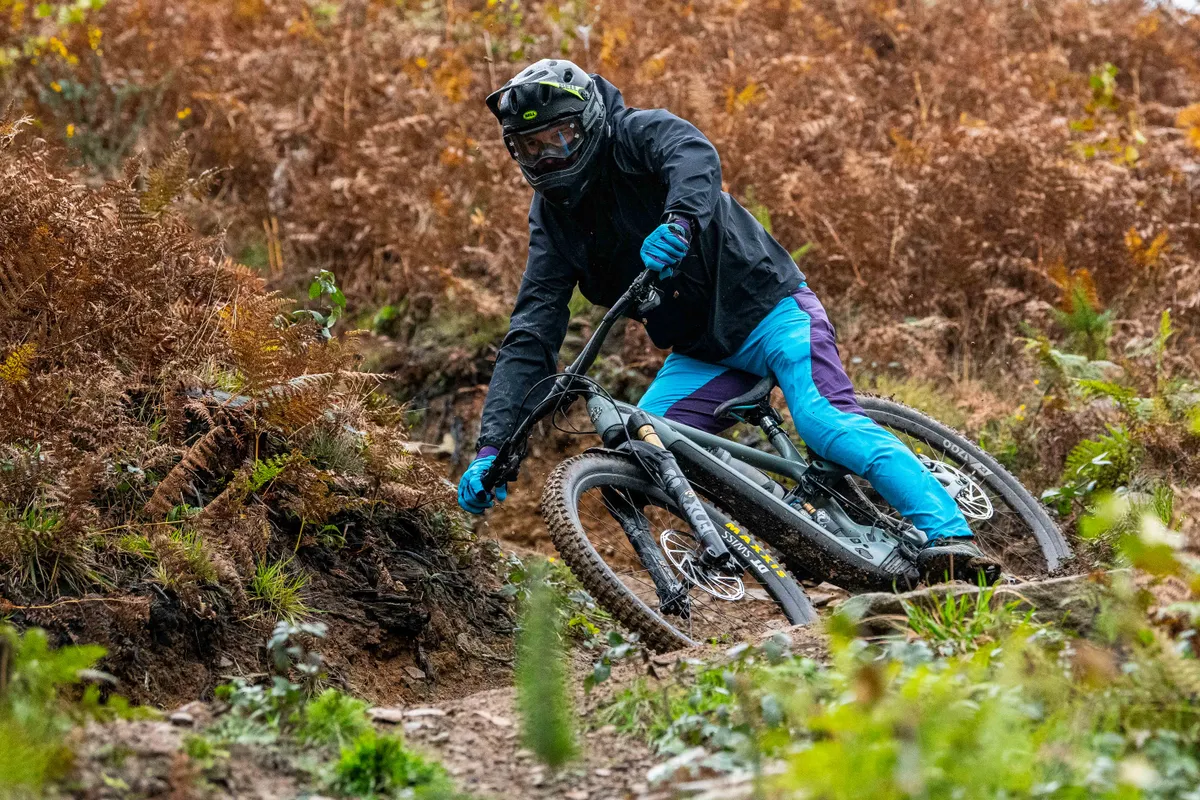
Before we get stuck into the review, it’s worth noting Shimano’s EP-8 motor failed during testing. However, after identifying the issue, Shimano has confirmed it would be covered by the motor’s warranty and, as a result, I have scored the 160E based on the performance of the bike alone. I’ll cover the motor failure later on, and share responses from Yeti and Shimano.
2022 Yeti 160E T1 frame specifications and details
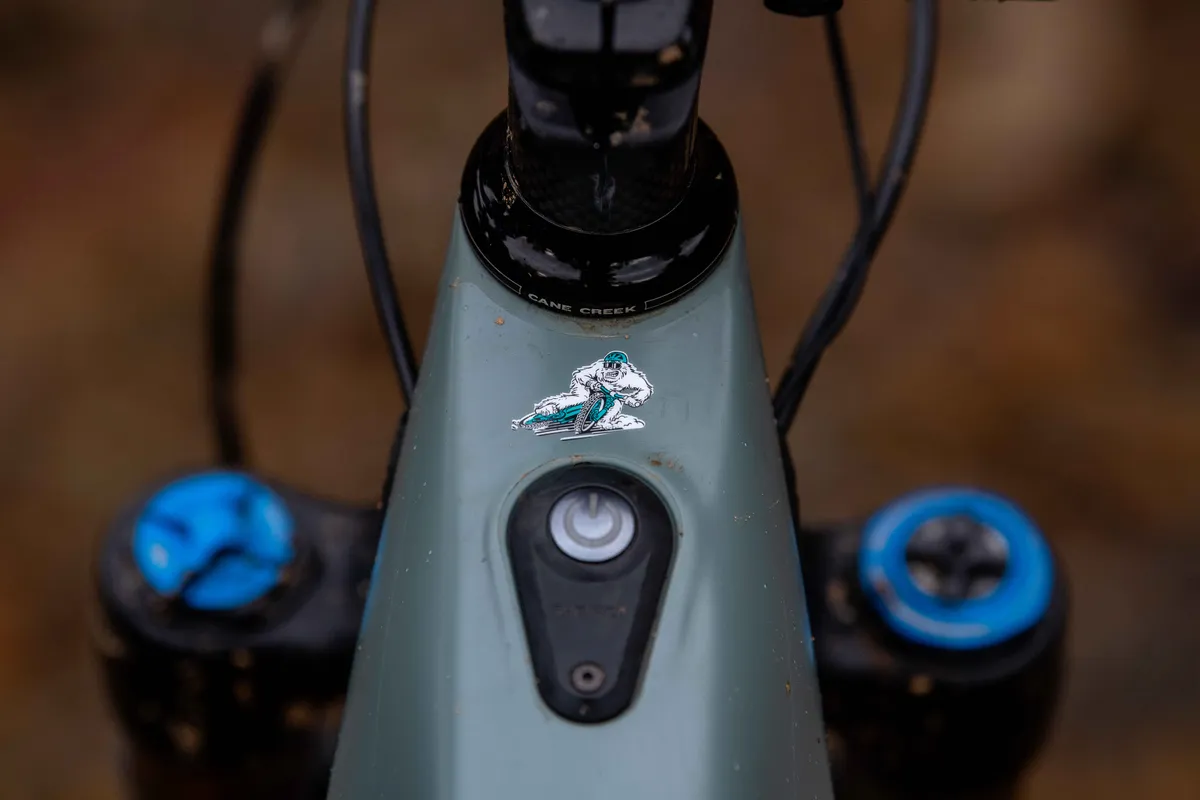
Both the T1 (reviewed) and more affordable C1 version of the 160E use the same frame construction and material, each built from Yeti’s TURQ-series carbon fibre.
This material is claimed to be the brand’s highest-quality carbon that “offers the perfect balance of stiffness and compliance” and has a lifetime manufacturer’s warranty.
It has full-length internal cable routing, with internal cable guides and integrated clips where the cables pass from the front to rear triangles, along with exit and entry clamps to stop them from rattling inside the tubes.
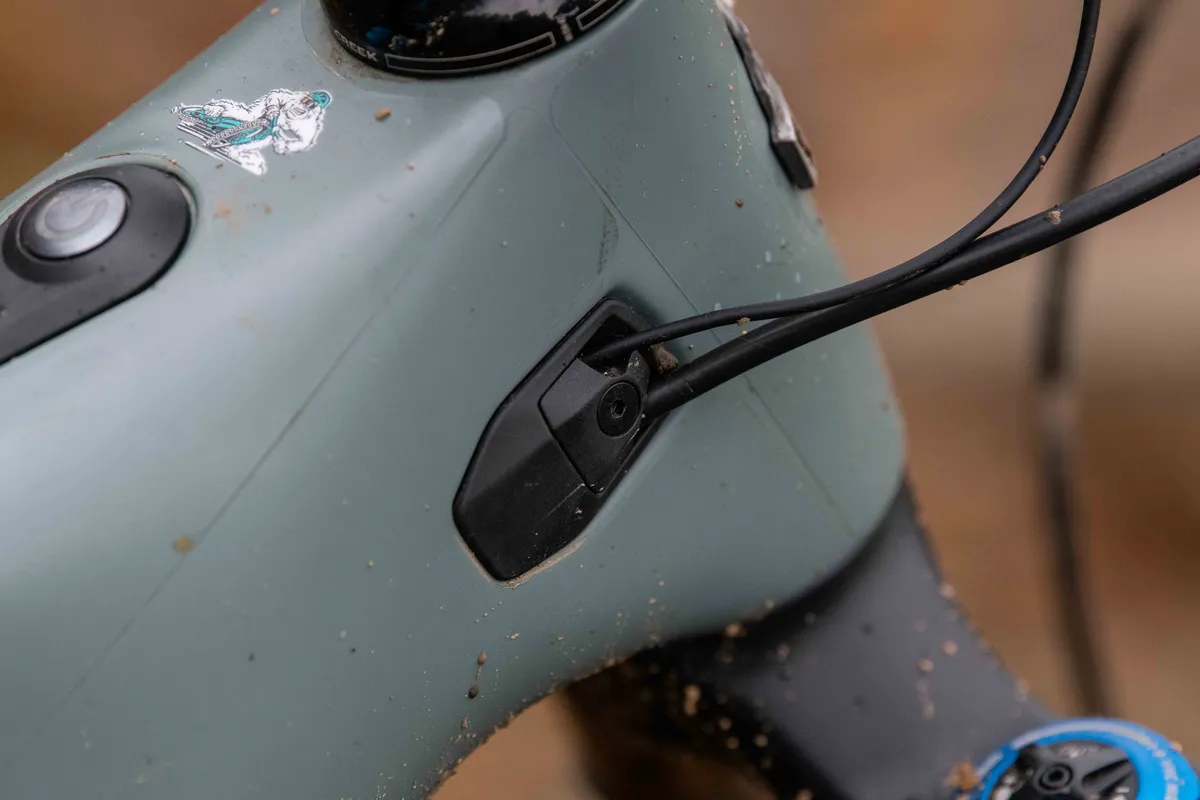
You’ll also find integrated ribbed chain slap protection on the drive-side chainstay to further suppress noise. There’s space for up to a 29x2.6in rear tyre, but it can also be run as a mullet setup (where the 29in rear wheel is replaced with a 27.5in hoop).
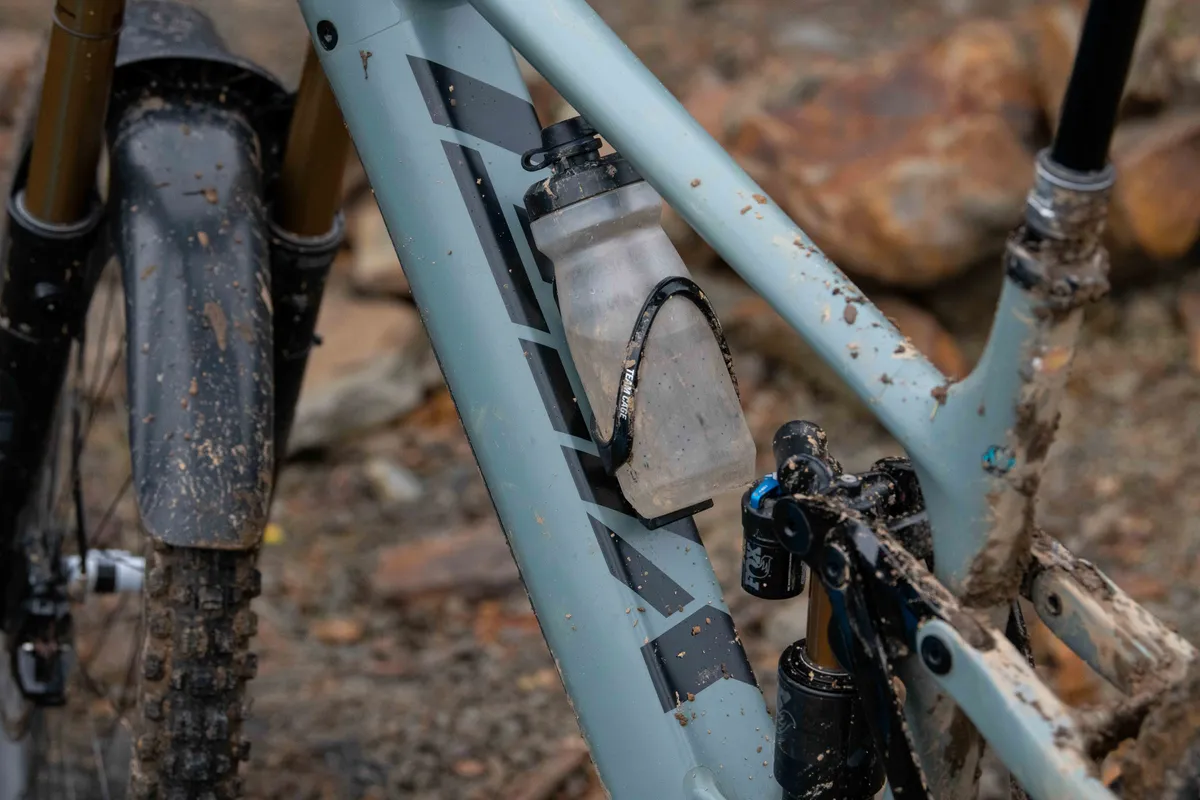
The 160E uses a 1-1/8in and 1.5in tapered head tube with an integrated headset. There’s space for a 625ml water bottle inside the front triangle on medium or larger bikes, but the small can only fit Yeti’s 443ml hot lap bottle. It has a Boost 12x148mm rear axle and uses SRAM’s UDH derailleur hanger.
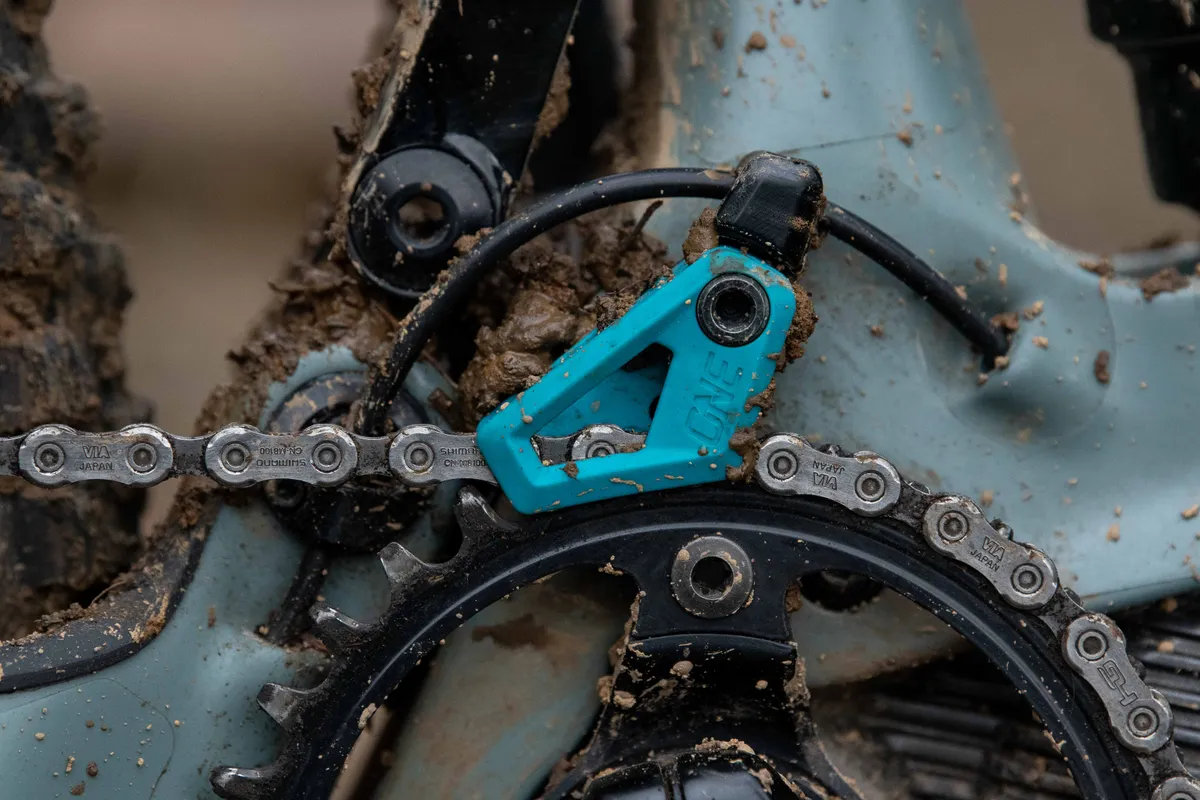
Chain retention is taken care of by an integrated OneUp upper chain guide with attached cable routing, but doesn’t have chain guide tabs, which means it isn’t possible to attach a lower bash guard or third-party chain guide. It’s compatible with 31.6mm seatposts and has internal routing ports for a stealth dropper post. The seat tube is straight with no interruptions to the bike’s bottom bracket to guarantee increased seatpost insertion depth.
Yeti says the 160E has been tested to downhill bike standards and is rated for use with up to a 190mm-travel dual crown fork, although it’s fitted with Fox’s 38 single crown fork with 170mm of travel from the factory. Yeti states it has a 130kg system (rider and bike combined) weight limit.
2022 Yeti 160E T1 motor and battery
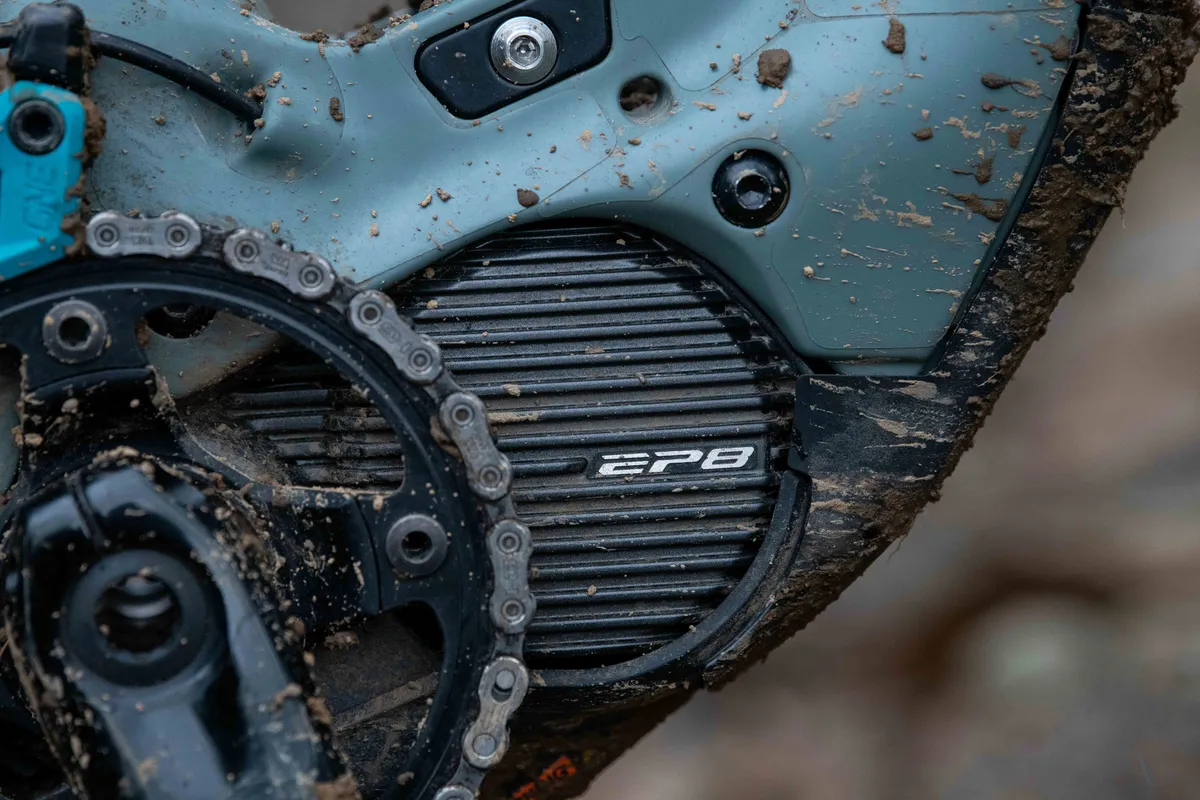
Mated to the 160E T1 is Shimano’s EP-8 motor and integrated 630Wh battery.
The motor provides up to 85Nm of peak torque, where each of its three modes (Eco, Trail, Boost) can be customised in the Shimano E-Tube Project app, along with over-the-air software updates via Bluetooth using a smartphone.
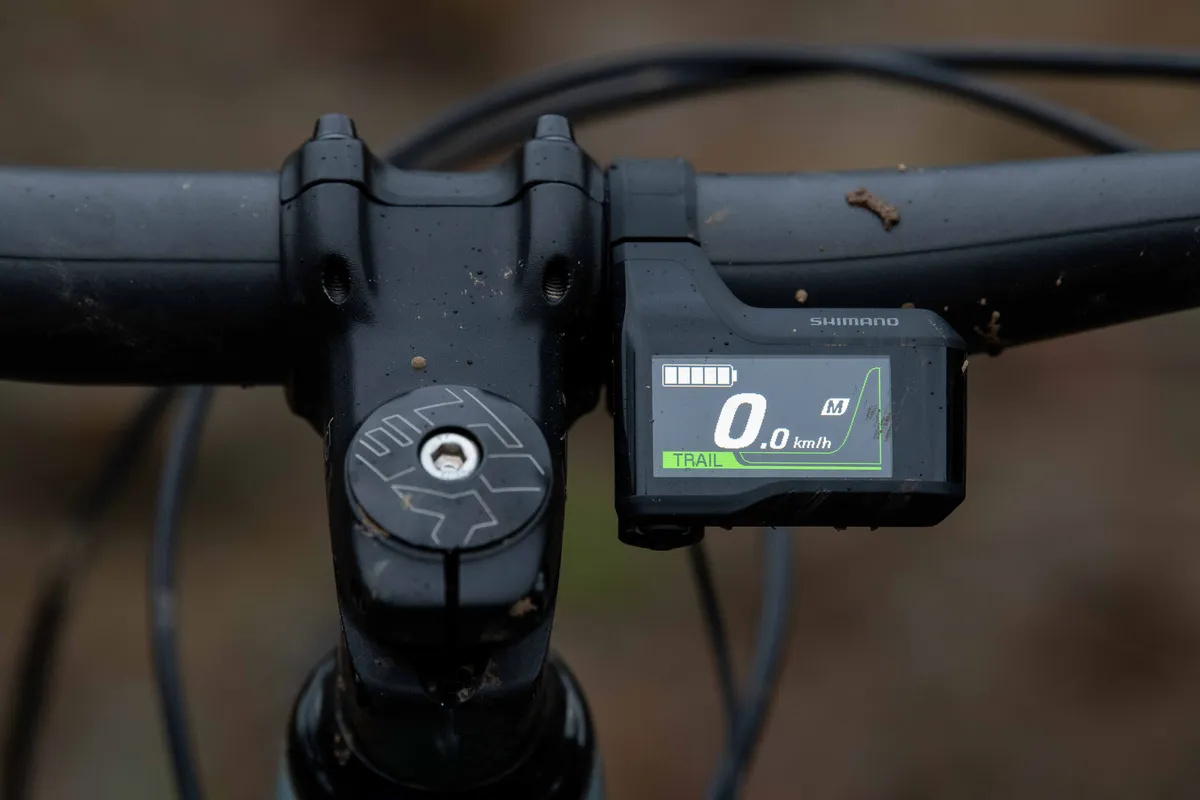
Yeti has specced Shimano’s EM-800 colour display and EM-800 mode control bar-mounted switch.
2022 Yeti 160E T1 Sixfinity suspension kinematics and adjustability
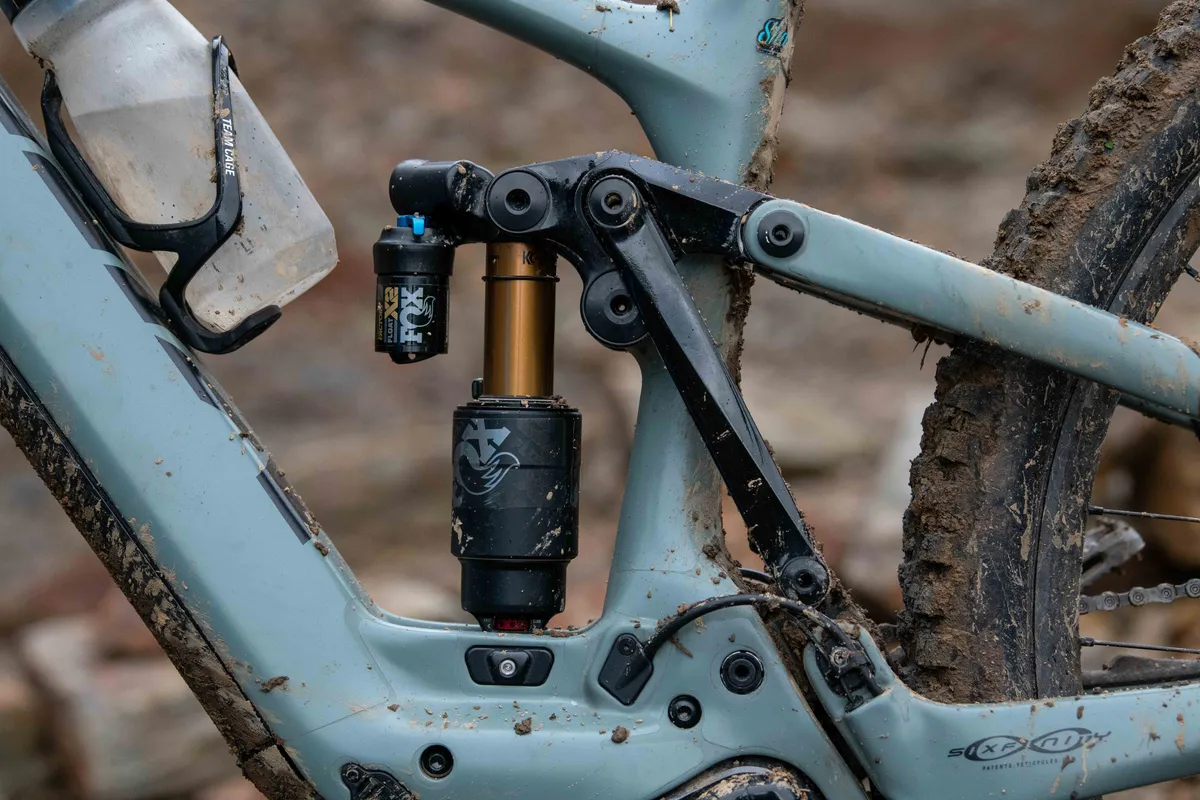
Arguably, it’s Yeti’s 160E Sixfinity suspension platform – a departure from its Switch Infinity system – that defines the company’s first ebike.
The move to this new 160mm-travel system, according to Yeti, was bred out of a desire to provide more tunability and address the unique demands – such as increased weight, torque and power – motorised assistance brings, hopefully making the frame considerably stiffer than other designs.
Although the six-bar design looks visually different to Yeti’s Switch Infinity system, it functions in a similar way. The lower Switch link initially rotates upwards as the suspension compresses, then changes direction and starts rotating downwards in the opposite way.
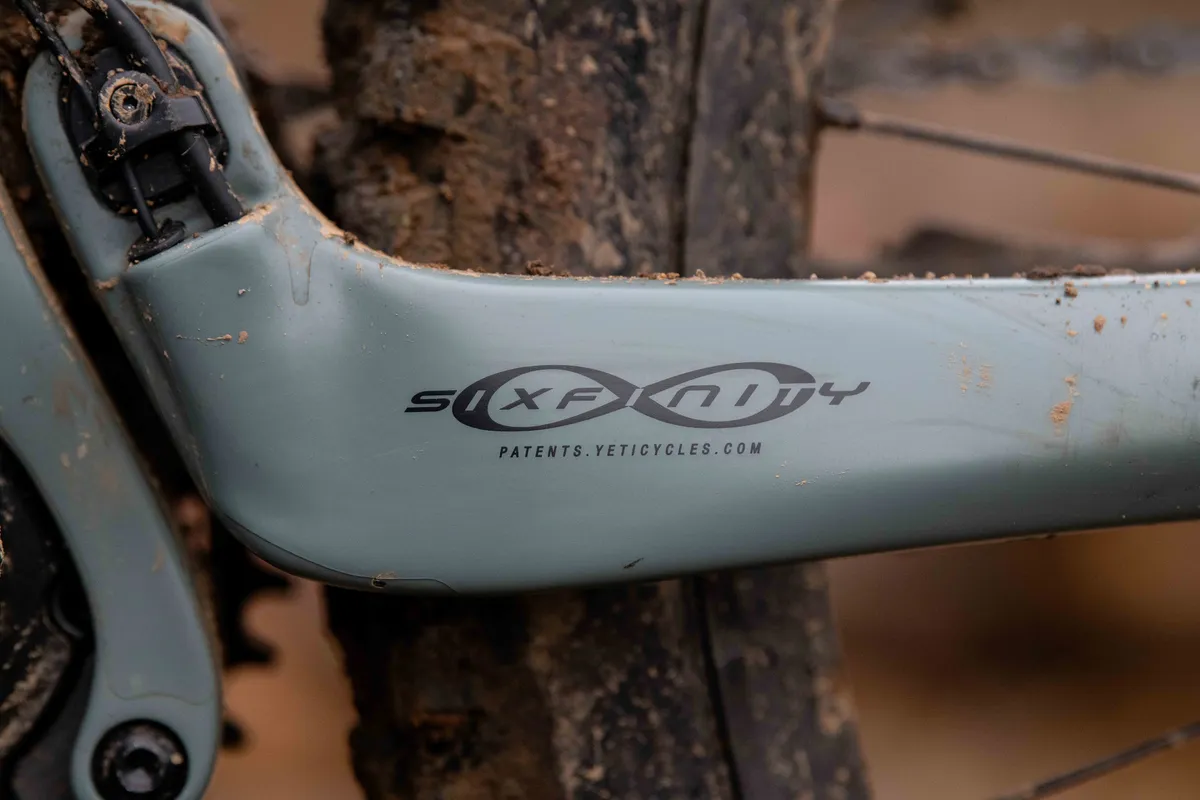
The upper rocker link is attached to the timing link, and as the rocker link (that attaches to the shock, seat tube and seatstays) moves, the timing link rotates around its pivot to control the direction (either up or down) of the Switch link.
Together, these links combine to create the bike’s anti-squat (how much a bike’s suspension resists compression caused by pedalling forces) and anti-rise (how much the suspension resists extension under braking) kinematics, and wheel axle path.
One of the benefits of this design is that anti-squat sits around 100 per cent from full extension up to 75mm of rear-wheel travel across the gear ratios. This means the rear suspension is well balanced against pedalling forces and should neither compress nor extend on the power within this travel range.
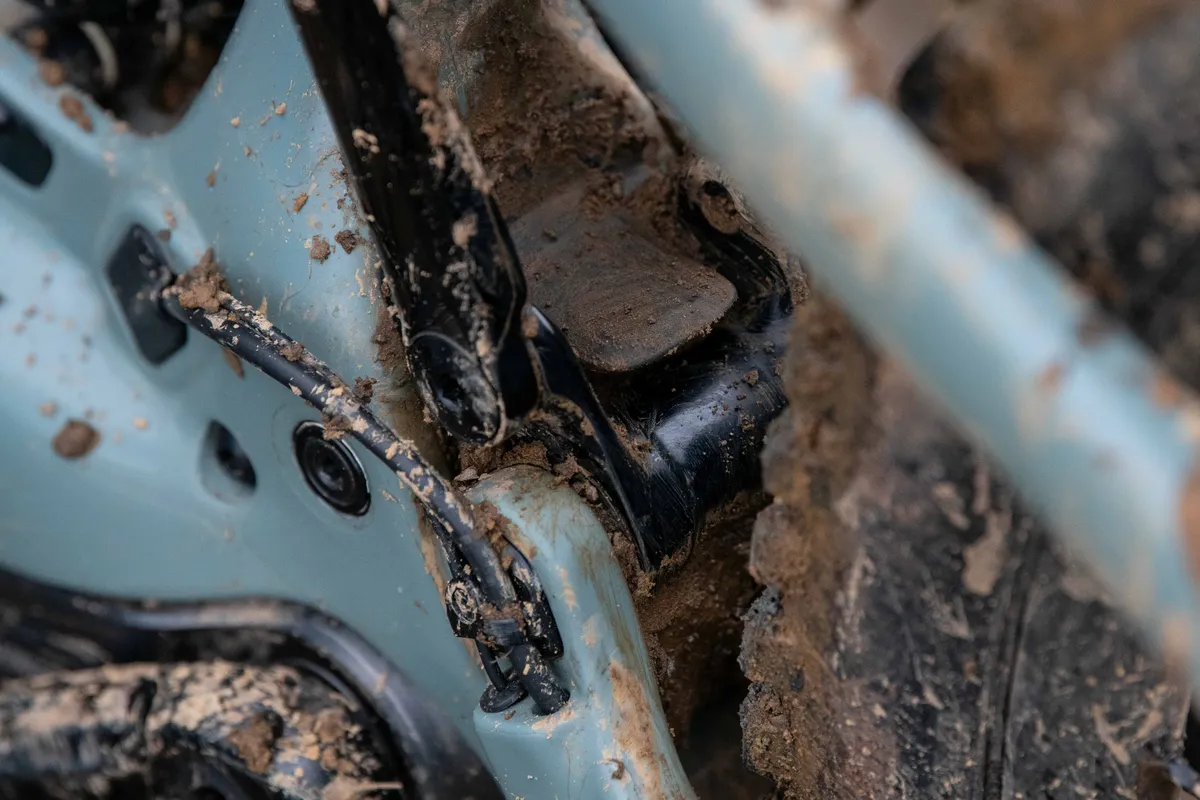
Similarly, anti-rise levels remain fairly constant throughout the bike’s travel, with an eight per cent change from between 58 per cent and 66 per cent from full extension to bottom-out. In theory, while braking, this can make the suspension feel more supple because braking forces give it a propensity to extend rather than squat (also known as brake jack).
The system has an in-built leverage rate adjustment to control how progressive it is thanks to a three-position lower shock mount.
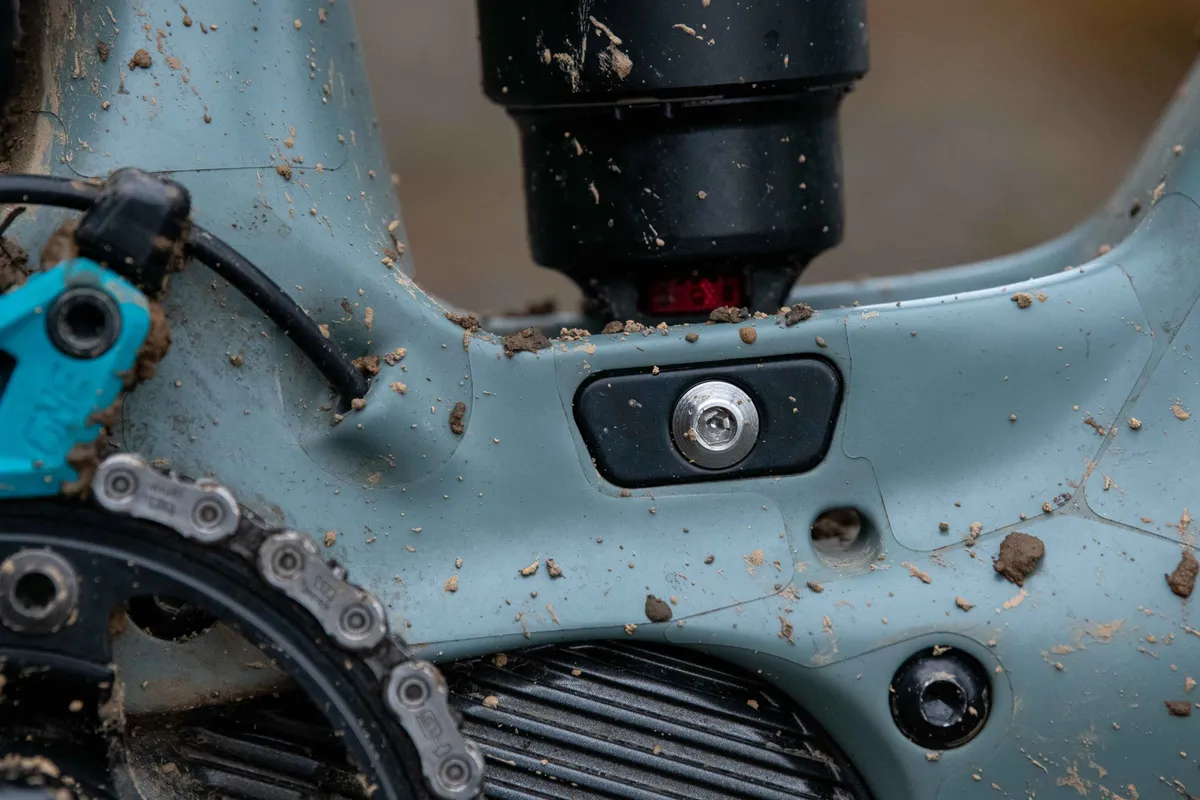
The middle position makes the suspension 30 per cent progressive, while the front is 25 per cent progressive, and the rear one 35 per cent.
This makes the 160E suited to coil shocks (with linear spring rates) and air shocks with no (or fewer) volume reducer tokens installed, because air shocks have inherently progressive spring rates.
Finally, the compact Sixfinity suspension has allowed Yeti to run a rear 29in wheel without the chainstays (446mm) growing too much. Yeti claims other brands are opting to use mullet setups (where the rear wheel is 27.5in and the front 29in) to help with keeping chainstay lengths down.
2022 Yeti 160E T1 geometry
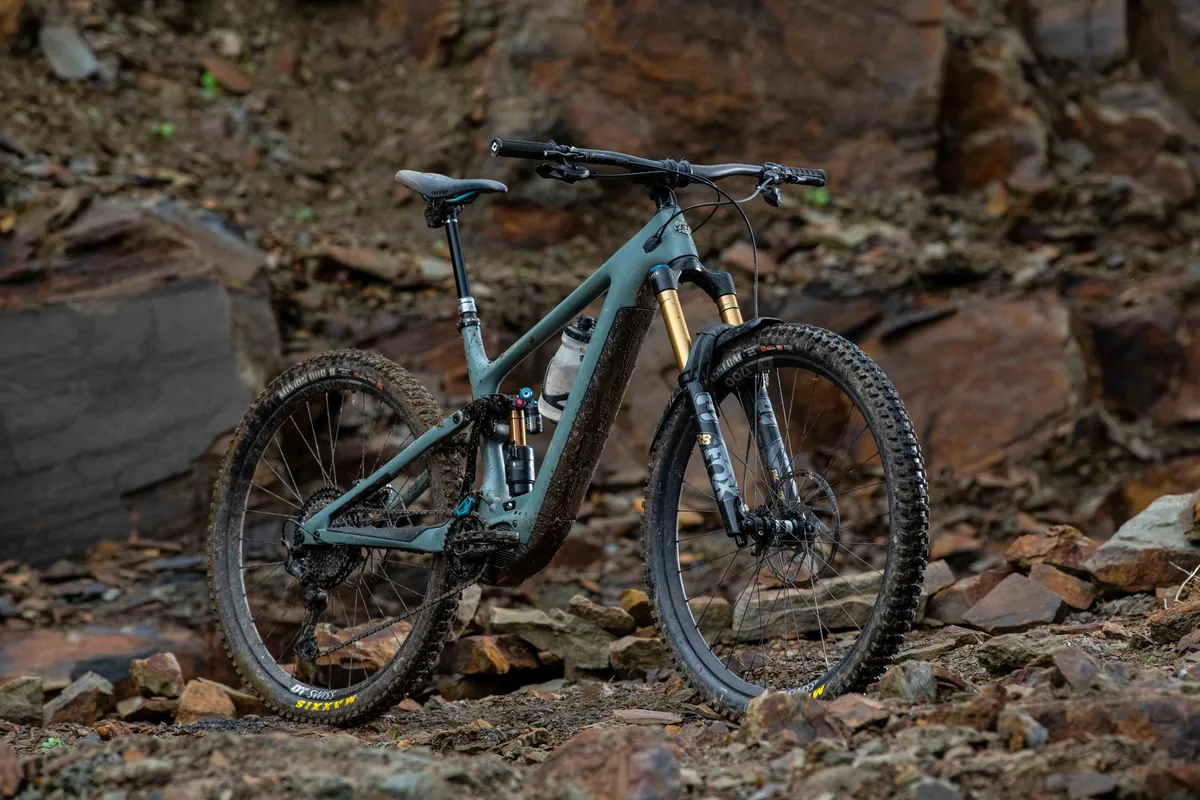
Geometry-wise, the 160E didn’t make a big splash when it was launched.
The 64.5-degree head tube angle and 480mm (size large, tested) reach figure aren’t groundbreaking. Equally, the 1,262mm (large) wheelbase figure and 446mm chainstays don’t shout ‘radical’ or ‘extreme’, though they are longer than Yeti’s non-motorised SB150 enduro bike.
The relatively steep seat tube angle, at 78 degrees, is good to see because it will place a rider’s hips more centrally over the bottom bracket, improving seated comfort and control compared to a slacker angle. The 350mm bottom bracket height is slightly lower than some other electric mountain bikes on sale, which could lead to pedal strikes given the travel on tap.
The geometry isn’t as adjustable as the bike’s suspension, and there are no geo-adjust flip chips. That said, because the frame is rated for use with a 190mm-travel fork and a 27.5in rear wheel, it could be possible to rake the head angle out further, and/or lower the bottom bracket.
Despite geometry figures that are progressive but not entirely groundbreaking, they make sense out on the trail and the 160E inspires plenty of confidence, but more on that shortly..
2022 Yeti 160E T1 specifications
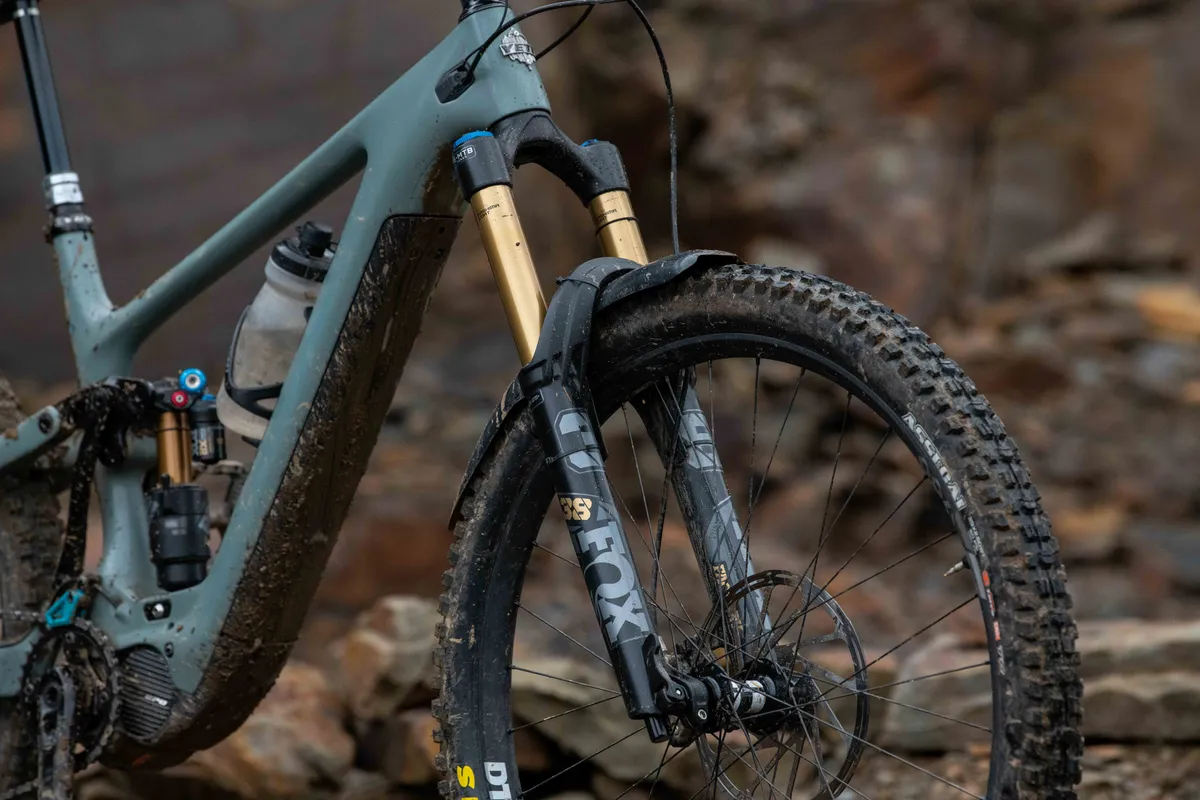
Although the 160E T1 is the top-spec and highest-priced model, it’s possible to upgrade the wheels from the aluminium DT Swiss EX 1700 to the pricier, carbon fibre DT Swiss EXC 1501 at an extra cost of $900.
Given the hefty asking price of the 160E, it is a little disappointing to see the EX 1700 specced as stock, given those rims are laced to the lower-grade 350 hubs rather than the 240 hubs fitted to the EXC 1501 wheels.
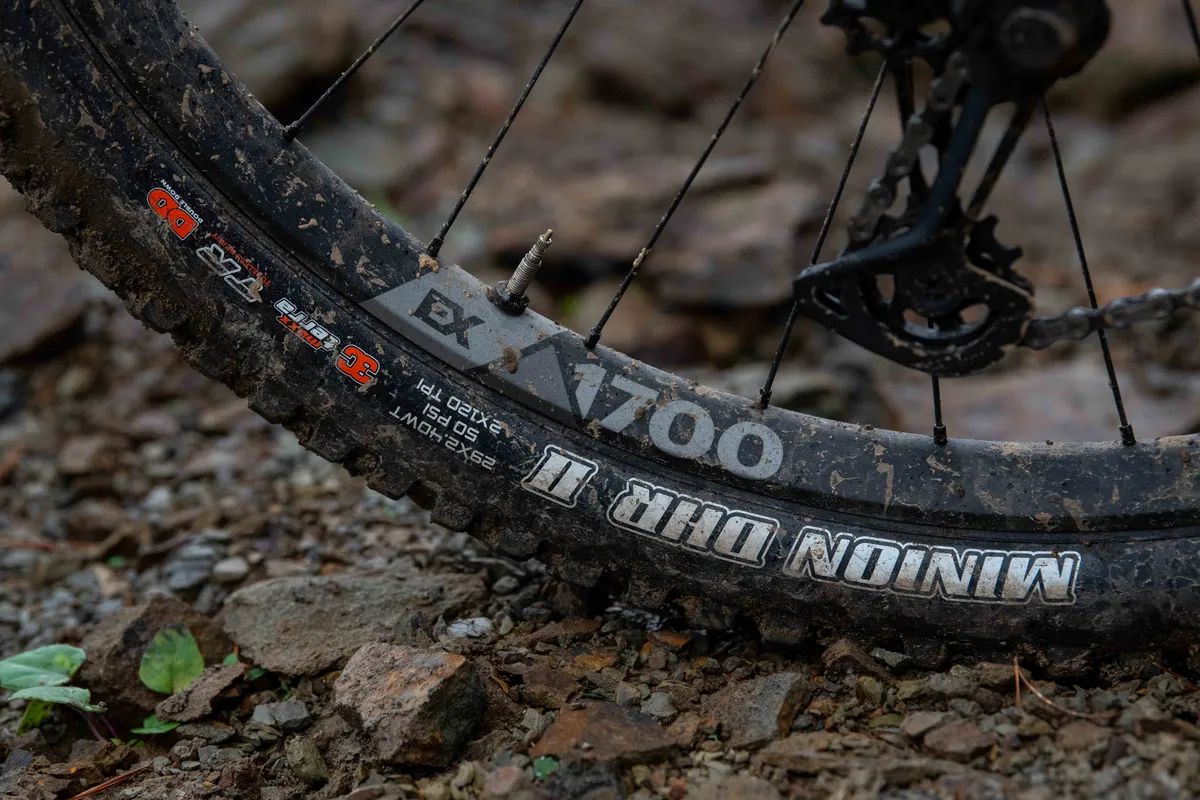
The Shimano XT M8100 drivetrain also sits one below the brand’s top-of-the-range XTR M9100. Once again, given the asking price of the Yeti, I’d expect a top-spec, no compromises drivetrain as we see on the similarly priced Specialized S-Works Turbo Levo, fitted with SRAM’s XX1 AXS components. The XT M8100 kit is a real workhorse, but this reliability comes with a weight penalty.
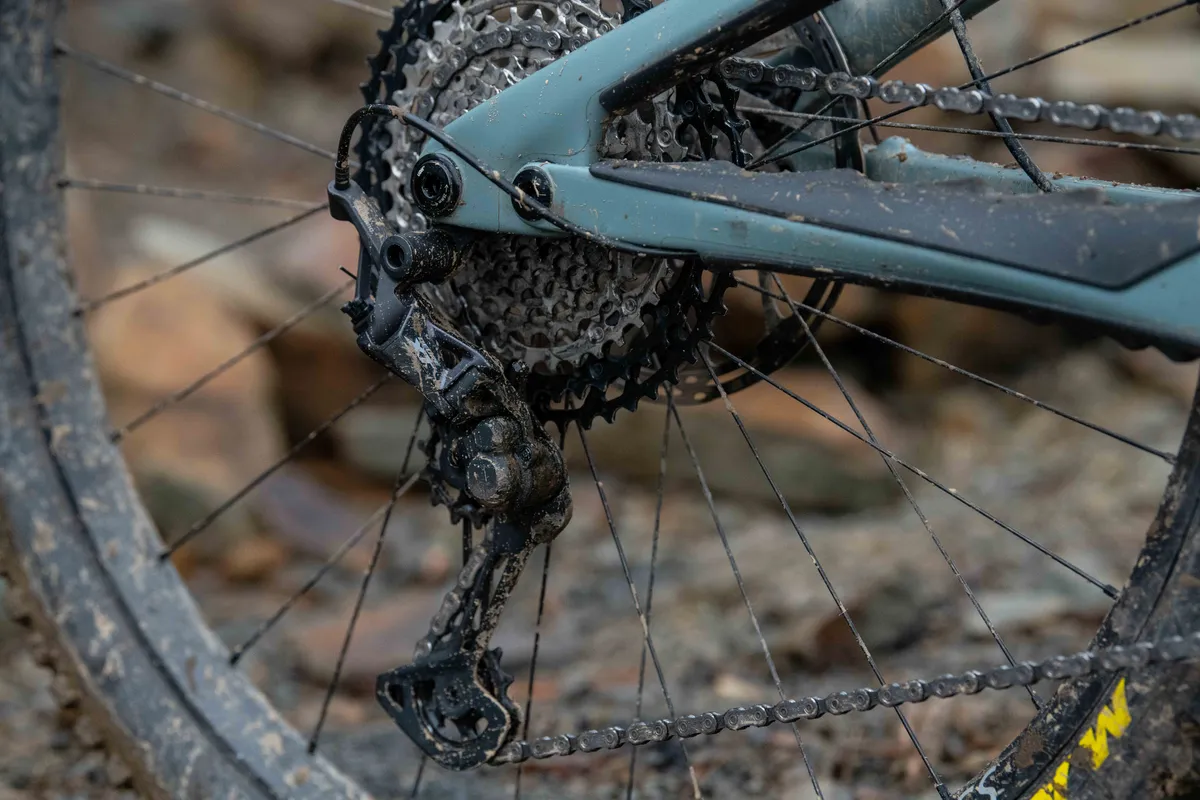
My final grievance lies with the 160E’s tyres. The brand has fitted Maxxis rubber, with a DoubleDown casing rear, and EXO+ casing front tyre. All good there, but then Yeti has skimped on tyre compounds, going for the harder-wearing but less grippy MaxxTerra versions over the much better MaxxGrip rubber.
You can safely bet your bottom dollar the Yeti EWS E-Series race team wouldn’t be running a MaxxTerra tyre on the front of its bikes. With this bike designed for enduro racing, why does Yeti expect the average consumer to do so?
Maybe supply constraints have dictated this spec choice, or maybe on the dry and dusty Colorado terrain where Yeti is based, the MaxxTerra tyre offers plenty of grip. Equally, MaxxTerra tyres are faster rolling than MaxxGrip versions, and could contribute to conserving battery power on climbs or flat sections. Elsewhere in the world – especially where it’s wetter – the compound is less suited to high-speed riding.
Those things aside, the Yeti 160E is well specced. The impressive Fox 38 Factory fork sits up front, fitted with the GRIP2 damper and 170mm of travel, mated with Fox’s Float X2 rear shock. Both fork and shock offer externally adjustable high- and low-speed compression and rebound damping and have volume-tuneable air springs.
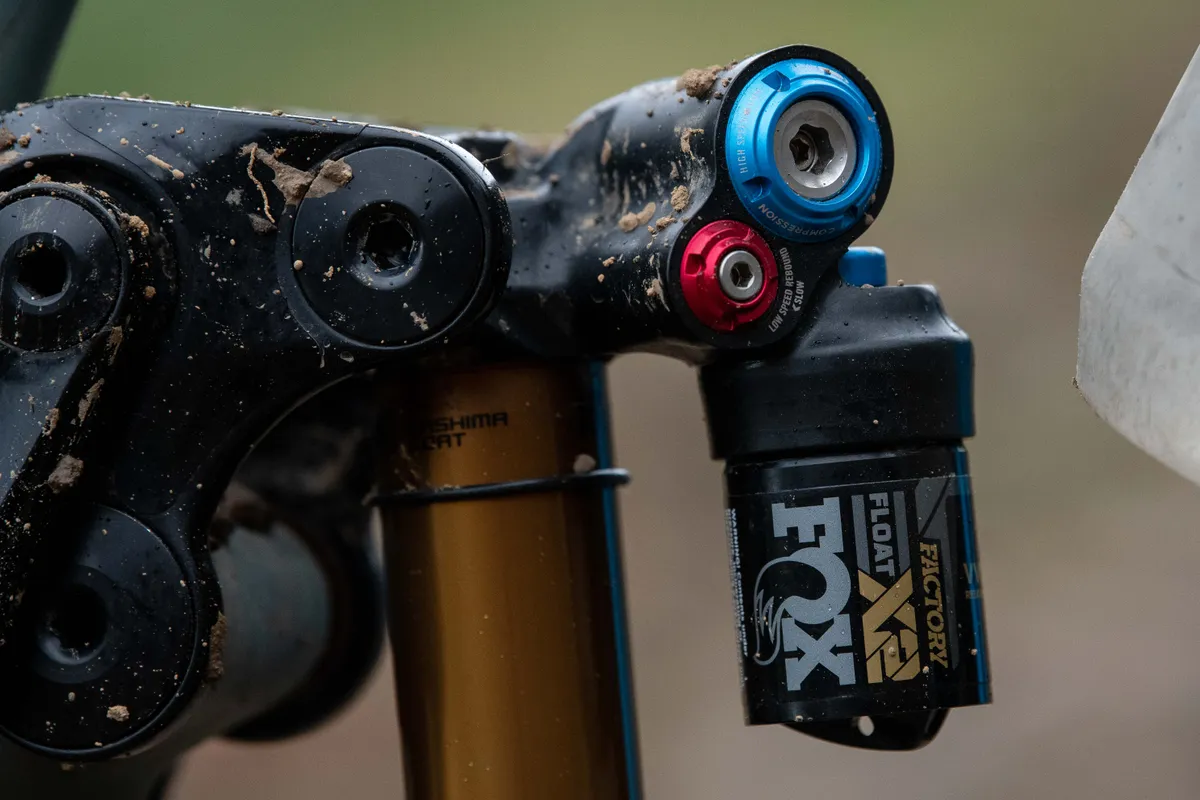
The 160E is also fitted with RockShox’s superb Reverb AXS wireless dropper post with 170mm of travel, matched with a WTB Silverado Custom saddle.
There’s a mix of finishing kit, with a Race Face Aeffect 50mm stem (not the Burgtec Enduro MK3 stated on Yeti’s website), and Yeti’s own ebike-specific thermoplastic handlebars that have ports and recesses for integrated controller and display wiring.
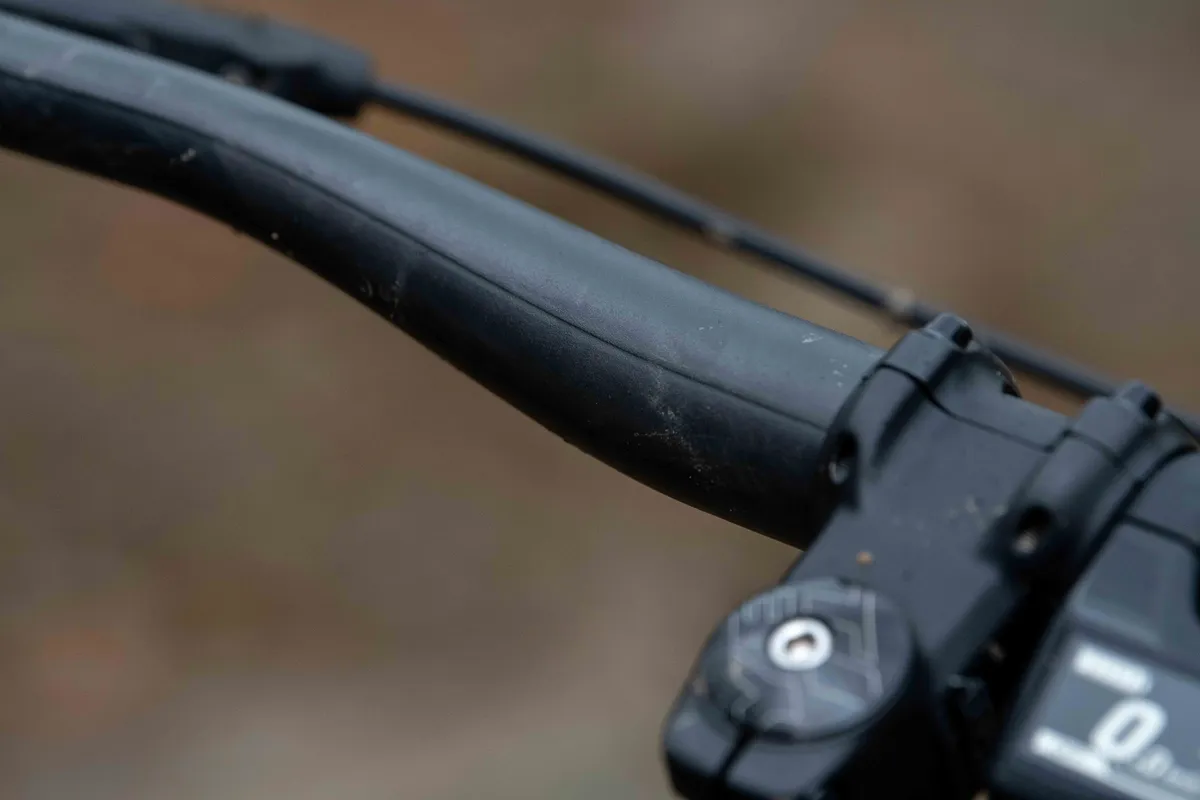
It’s fitted with ODI’s Elite Pro grips, but these have a large flange on their external edge. If, like me, you hold your bars with your hands over the edge of the grips, these are extremely uncomfortable to use and something I would need to swap out at the point of purchase.
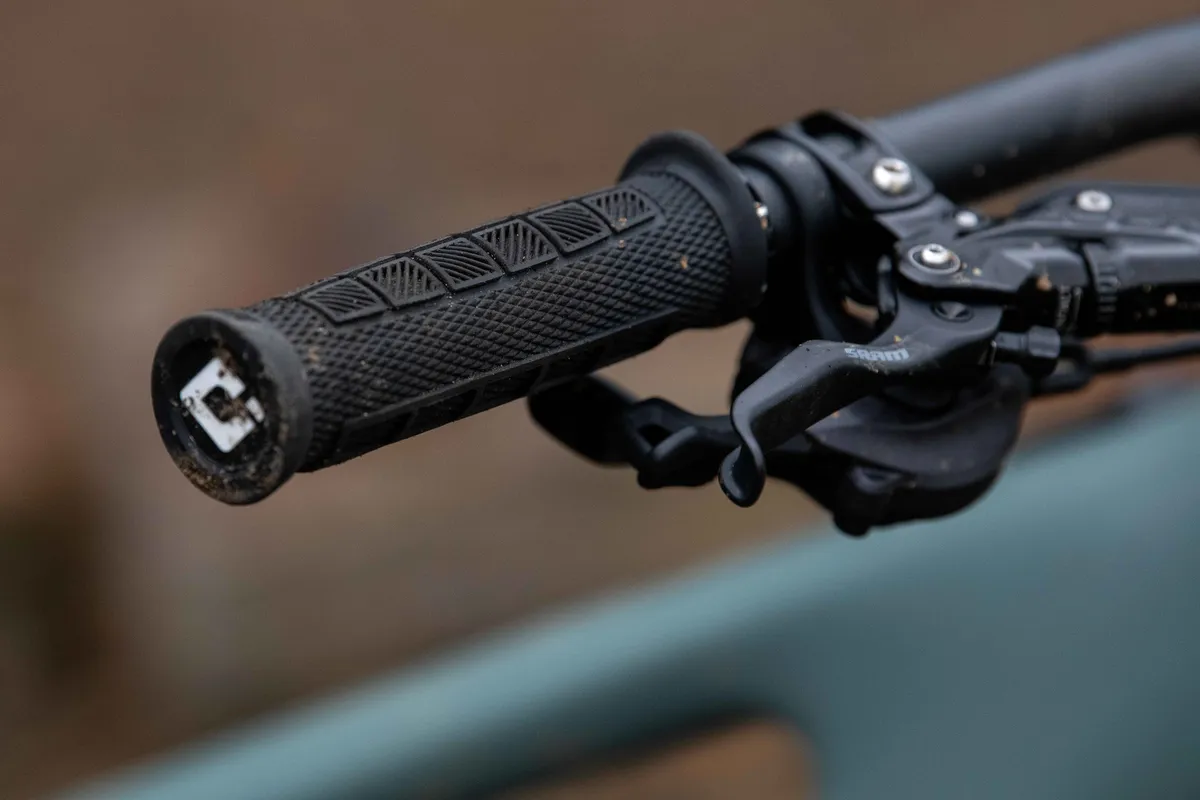
Stopping power is provided by SRAM Code RSC 4-piston disc brakes, fitted with a 220mm rotor on the front and a 200mm rotor on the rear.
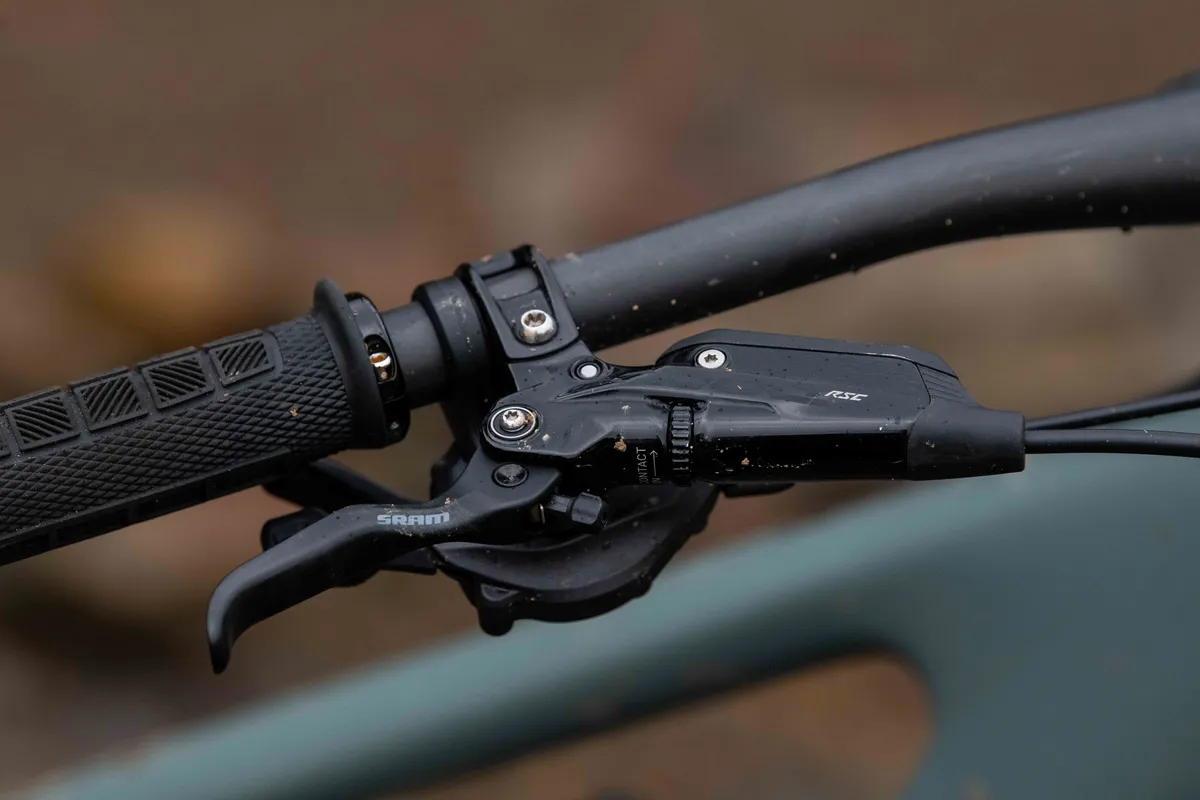
The size large test bike I rode weighed 23.45kg without pedals.
Is the Yeti 160E T1 good value for money?
The short and arguably subjective answer to this question is no, in my opinion, though assessing the relative value of any five-figure flagship bike is a tough ask and a personal judgement. The EX 1700 wheels aren’t poor performers, but riders will need to lay down extra cash to access the top-spec EXC 1501 hoops, arguably more fitting for the 160E’s asking price.
Similarly, the XT M8100 drivetrain, while excellent, isn’t the halo-level kit I would expect to see on a bike with an asking price north of £10,000.
Yeti told me it decided to spec the XT-level kit because its enduro team uses it, and the gram savings and perfrmance increases offered by XTR M9100 aren't needed on the ebike.
A lot of the bike’s purchase price will be hinged on the frame’s development and manufacturing, but other brands (such as Specialized) offer top-spec components on their top-spec bikes costing a similar price.
How I tested the 2022 Yeti 160E T1
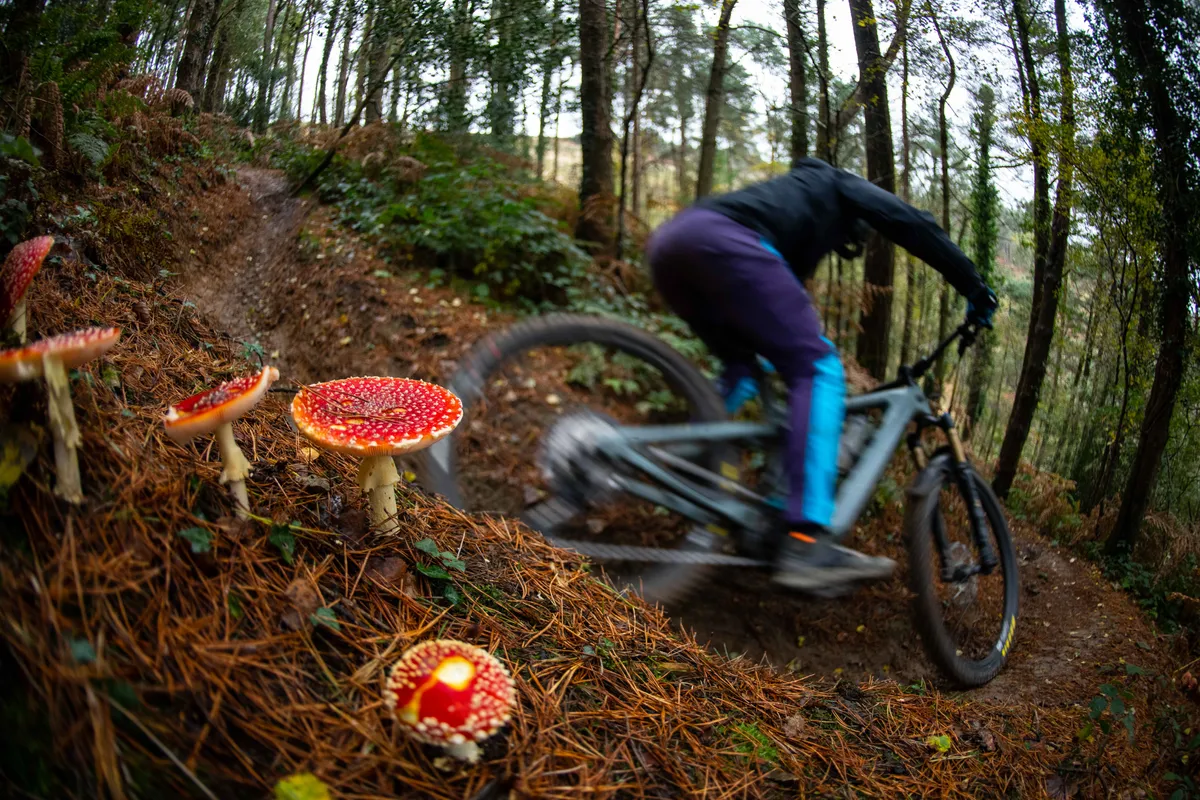
I got my hands on the Yeti 160E the same weekend the Enduro World Series visited my home trails in Scotland’s Tweed Valley. As a result, I was able to test the bike on the terrain it has been designed for – enduro race tracks.
Luckily, these are also my well-trodden test loops, giving me the advantage of not needing to learn new trails and being able to compare the 160E to other bikes I’ve recently tested.
Trail conditions ranged from late-summer hard-pack with a sprinkling of dust to autumn hero dirt, greasy mud and claggy bog, right the way into early-winter wet-as-a-river downhill runs.
I tested the bike on a host of trails, including natural, freshly built descents with soft dirt, well-ridden enduro race trails featuring rocks, roots, steep sections, flat-out lines through the forest and out on the moors, and downhill-specific trails usually accessed with an uplift vehicle.
I also took the bike around the famous Glentress trail centre loops to really get a flavour of its scope and versatility.
It would be fair to say that over the 246km test period, I got a very good taste of how the 2022 Yeti 160E performs. However, my time on the bike was cut short thanks to an E010 error thrown up by the Shimano EP-8 motor, but more on that below.
2022 Yeti 160E T1 ride impressions
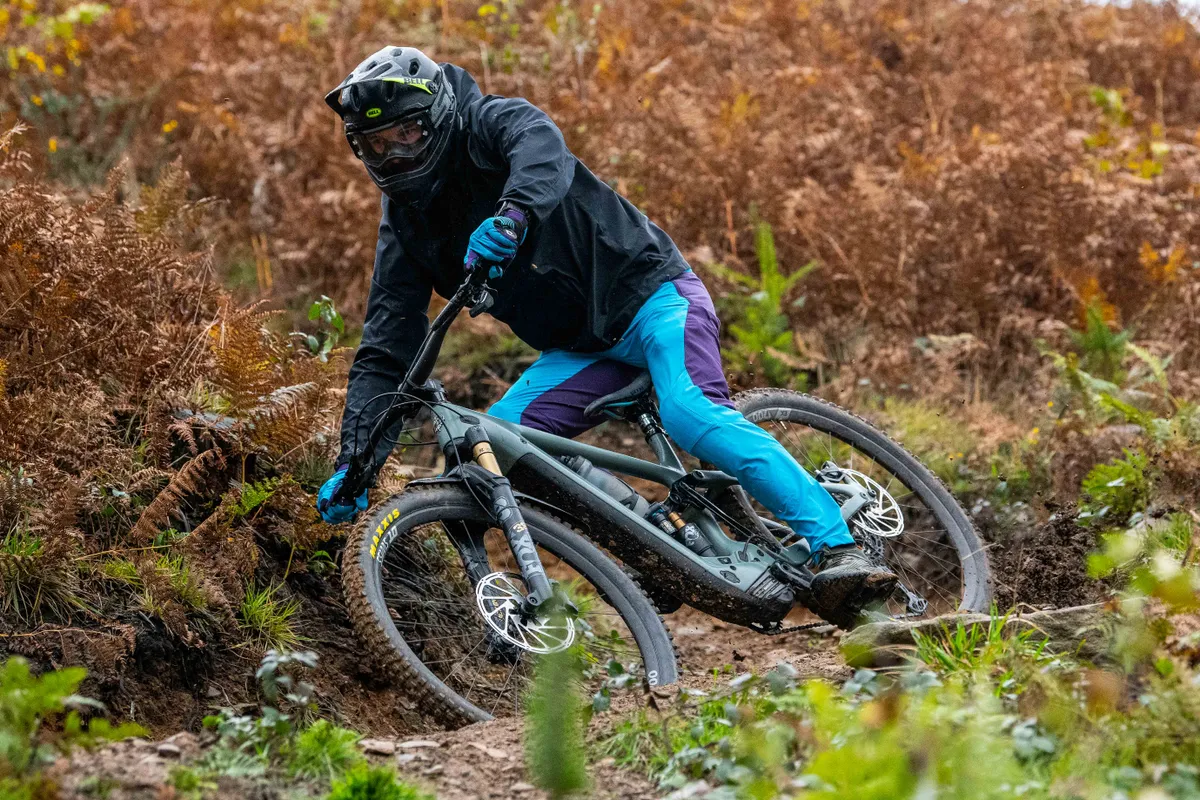
2022 Yeti 160E T1 setup
After fettling the rear suspension, I ended up leaving it in the 30 per cent progression setting for the duration of the main test period. I found this offered the best balance of initial stroke suppleness, mid-stroke support and an increase in progression as the shock reached the ends of its travel.
Yeti’s website has a dedicated shock setup guide, where you input your details and it works out how your suspension should be set, and even how hard your tyres should be.
For my weight, Yeti recommended 19.5mm of shock stroke sag, plus (from fully closed) -6 clicks of high-speed compression damping, -10-12 clicks of low-speed compression damping, -4 clicks of high-speed rebound damping, and -10-12 clicks of low-speed rebound damping. No spring volume reducer tokens are recommended.
These settings are roughly in the middle of the damper’s adjustment range.
For the fork, Yeti recommended roughly 87-93psi, with -6 clicks of high-speed compression damping, -10-12 clicks of low-speed compression damping, -7 clicks of high-speed rebound damping and -8-10 clicks of low-speed rebound damping. Yeti doesn’t recommend installing any volume reducer tokens.
After using Yeti’s recommended settings, I felt as though the fork and shock were choking on both their rebound and compression strokes, thanks to the well-documented highly damped feel of the Fox suspension.
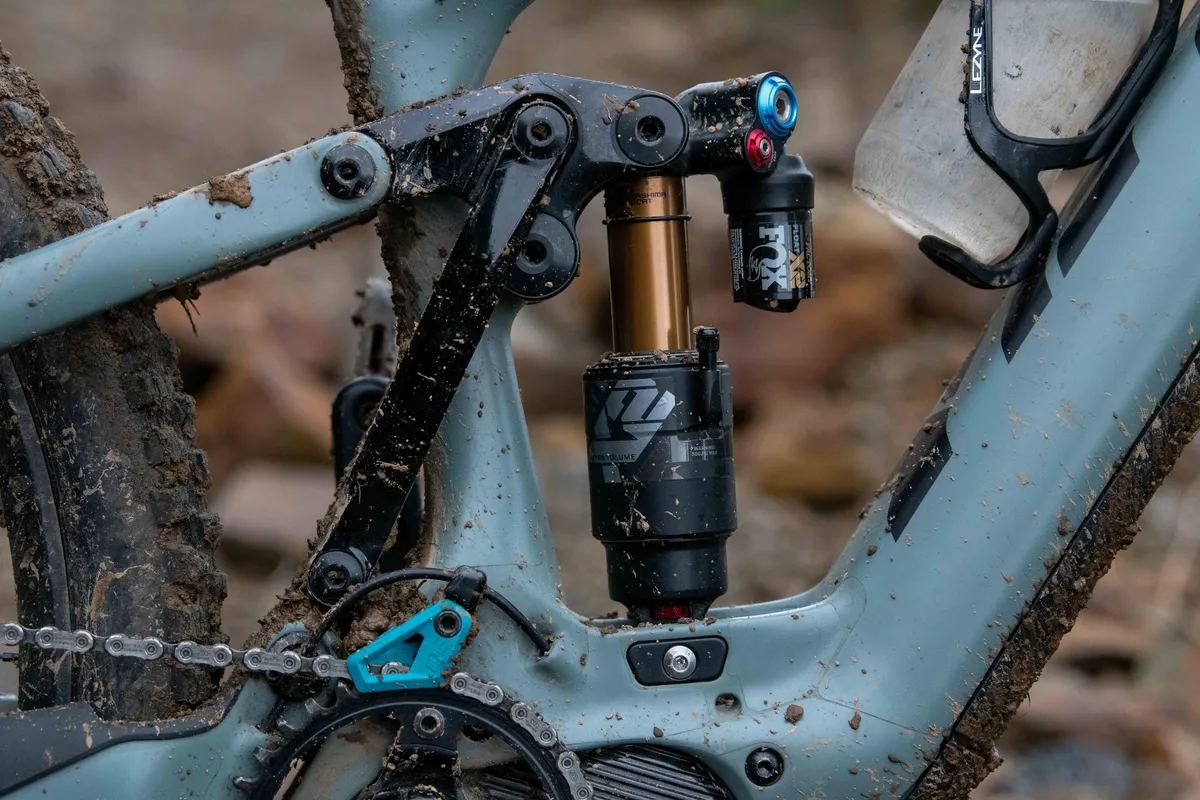
After winding the damping off entirely to get the fork and shock moving more feely, I needed to add a bit of shock and fork spring pressure, reducing sag to 18mm or 27.69 per cent of the shock’s stroke. Thanks to the progression in this setting, I didn’t feel I needed to add any volume reducer tokens.
Up-front, I settled on 98psi, with 30mm or 17.65 per cent sag, but installed three tokens to aid with bottom-out resistance.
Yeti’s tyre pressure recommendations were between 25-27psi for the front and 27-29psi for the rear, both figures very close to my own settings. I ended up with 25.9psi front and 26.7psi rear, both lower than I would usually opt for, thanks to the MaxxTerra compound tyres not gripping as well as I hoped (you can also read our guide to finding the right mountain bike tyre pressure).
Although Yeti’s suspension setting recommendations were a good place to start, the inherently heavy damping of the current Fox suspension means that winding off all the adjustment is the best way to avoid harshness and spiking, relying instead on the spring for support.
2022 Yeti 160E T1 climbing performance
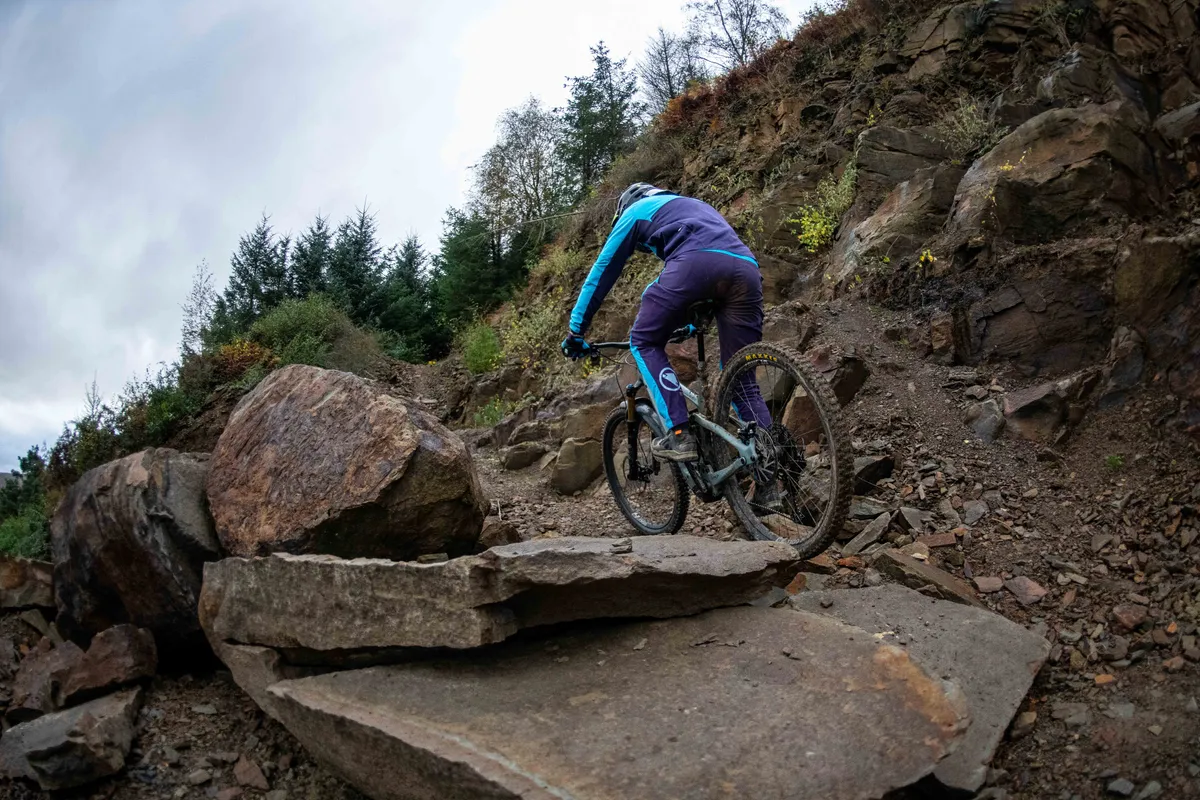
The super-plush feel of the rear suspension dominates the 160E’s character on the climbs.
Thanks to the highly progressive leverage rate (whether the bike is in the 25 per cent, 30 per cent or 35 per cent setting), it’s possible to run the rear shock at the softer end of the spectrum without worrying it will sag too much into its mid-stroke or bomb through the travel over larger hits and compressions.
Traction rich
The fluttery off-the-top motion of the rear suspension means it delivers an enormous amount of grip on bumpy, chunky and rough terrain, where the back wheel spends most of its time in contact with the ground.
The 160E can deliver grip where you wouldn’t expect it, and if I kept the pedals turning and motor delivering power to the back wheel, I was able to scale some of the hardest, most technical sections on my test loops without issue.
The limits of the bike’s grip are more related to the rear tyre’s tread profile and compound rather than the suspension’s ability to track the floor, where boggier, muddier ascents usually end with moments of wheelspin that stall forward progress. Although the Minion DHR II tyre is one of the grippiest around, its generalist tread pattern is less suited to super-claggy conditions.
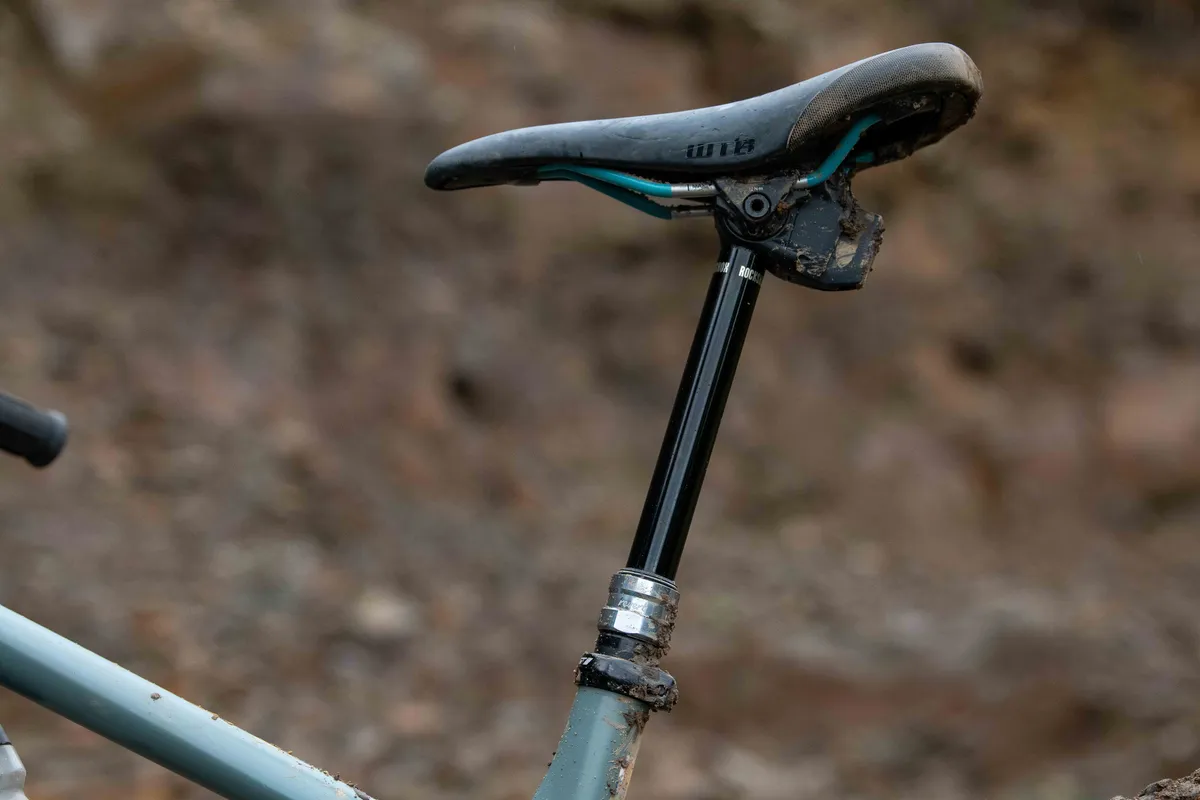
Furthermore, the MaxxTerra compound means the tyre frequently slides across angled roots or rock edges rather than sticking to them. To mitigate against this, I ran lower tyre pressures than I would usually, to aid with sidewall and tread deformation to improve bite.
Nonetheless, the 160E is one of the most impressive climbers out there, especially on drier terrain.
And along with the grip provided, that absorbent rear end improved comfort massively, especially when hightailing it around rough, worn-out trail centre loops. Remaining passive on the bike is as rewarding as riding it actively, as little seems to upset its chassis or trajectory.
Top trump geometry
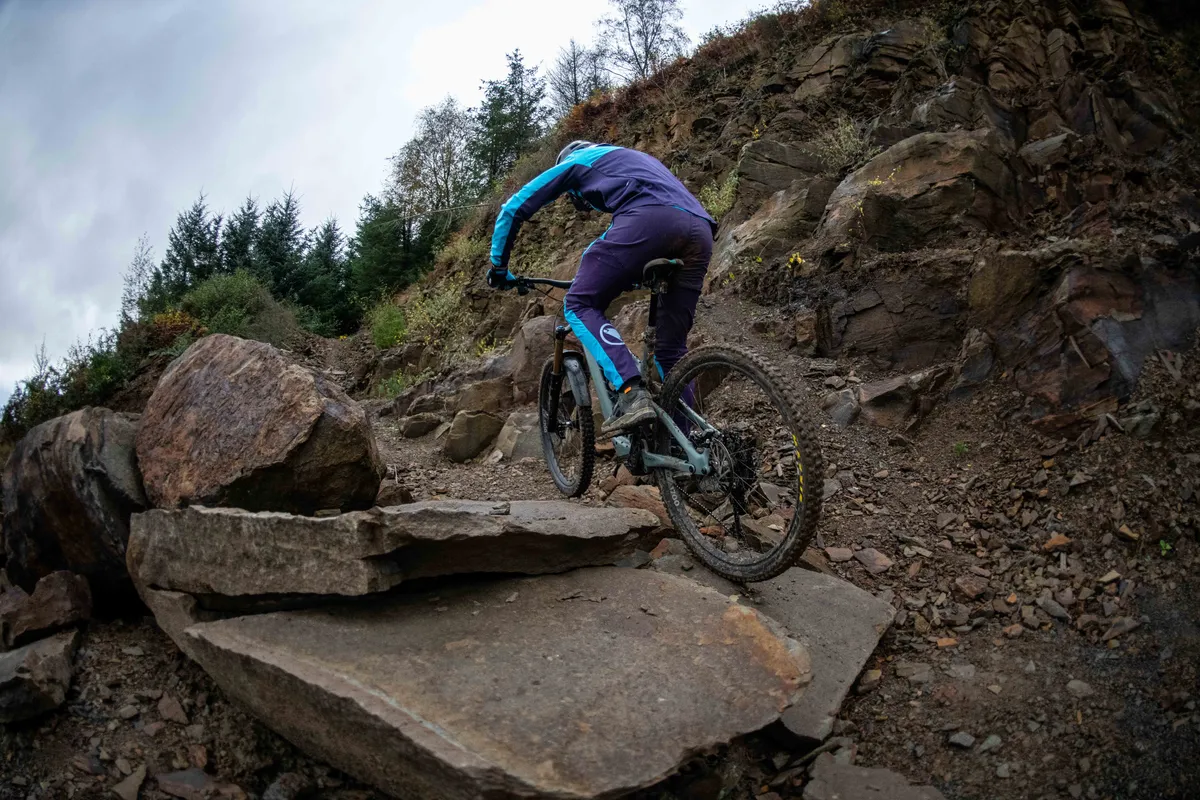
Despite the less-than-headline-grabbing head angle and reach figures, the 160E’s seat tube angle – 78 degrees – meant my hips were positioned comfortably over the bike’s bottom bracket.
This aided climbing comfort by naturally distributing my weight evenly over the front and rear wheels, and on very steep climbs reduced the need to lower my weight over the handlebars to stop front-wheel lift.
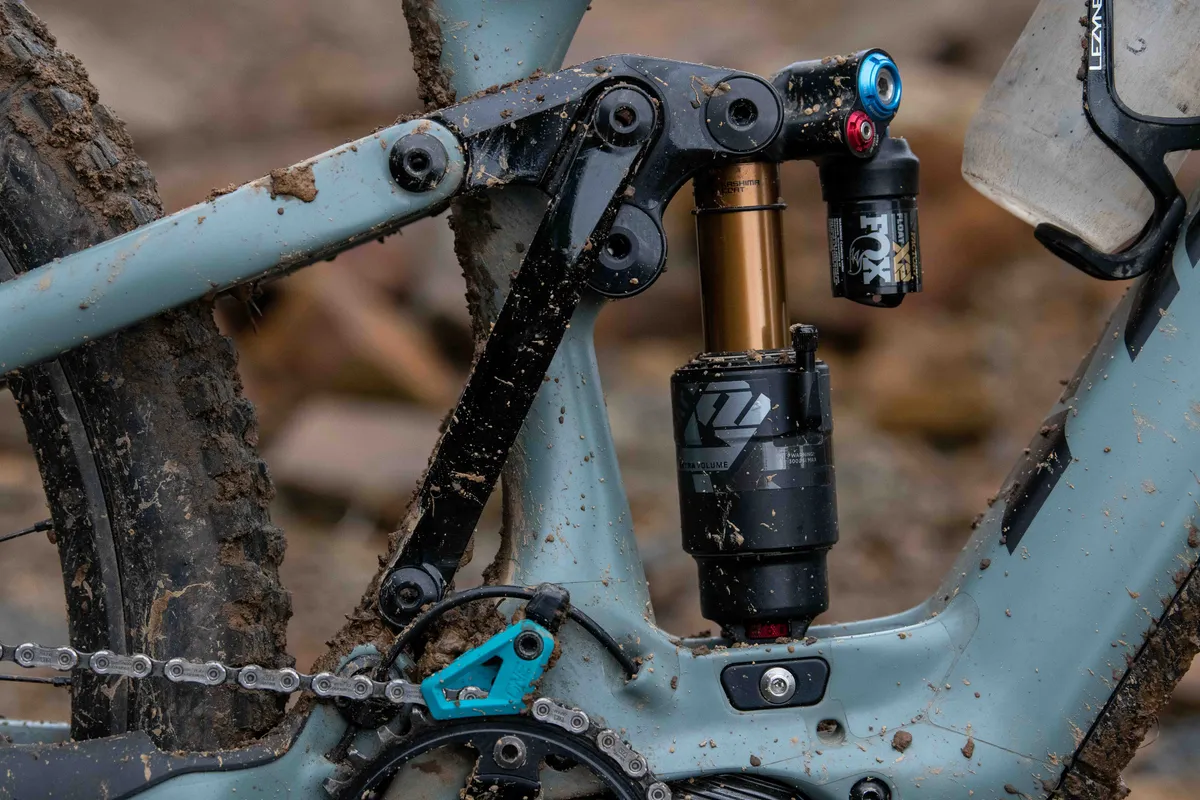
The dynamic geometry is also aided by the supportive suspension. On steeper sections, where bikes with less supportive suspension would sag into their travel as a rider’s weight is transferred on to the rear wheel more, causing the seat tube angle to slacken out compounding this problem, the 160E resists this extra sagging.
The bike compresses to its sag point and then sits there, where the rear end’s ramp is easy to sense. As I’ve mentioned, this also means it can be run fairly soft without a corresponding effect on the climbing geometry, and there’s no need for compensatory measures such as angling the saddle’s nose down and pushing it forward on the seatpost’s rails.
EP-8 Power
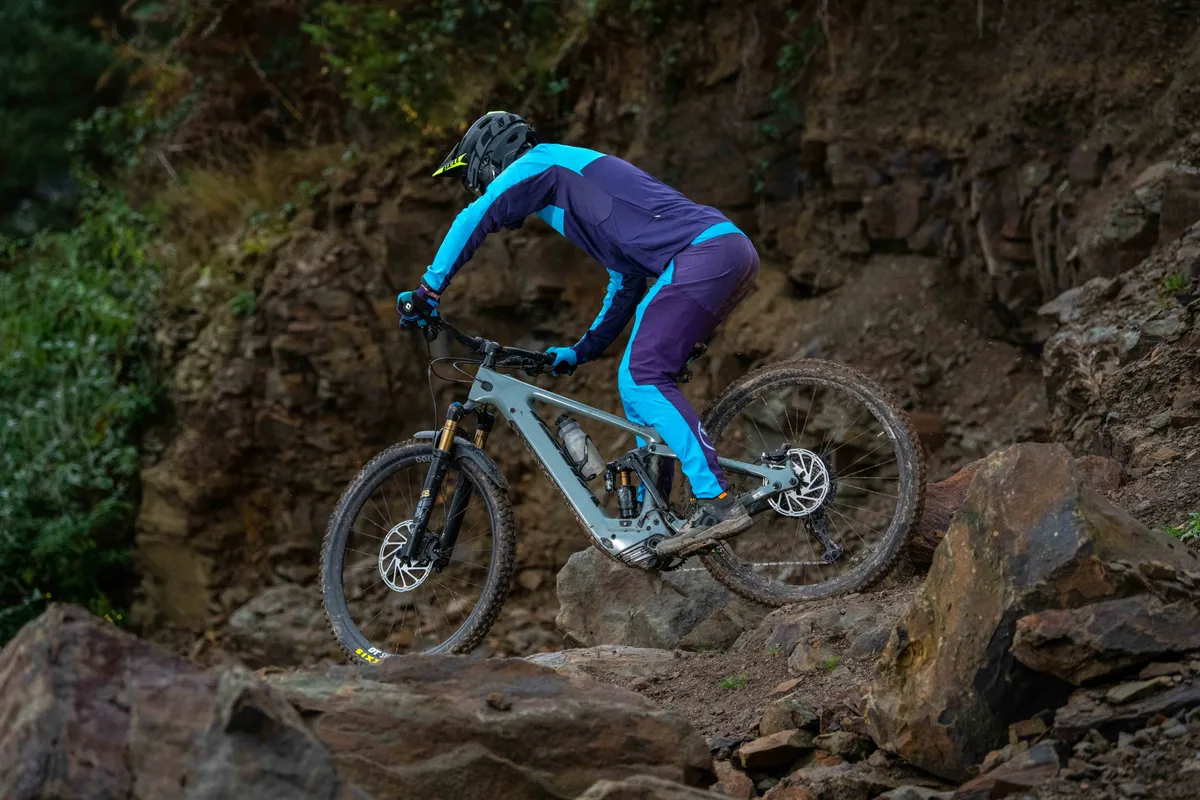
After spending a significant amount of time on the Specialized S-Works Turbo Levo, fitted with the Brose motor, my baseline motor comparison had been recalibrated somewhat.
For the EP-8 fitted to the Yeti, that meant its power felt much more on/off than the Brose, where pedal strokes – especially in the Turbo setting – span the back wheel easily if care wasn’t taken.
Although this was manageable, and much less noticeable in the lower-powered modes, it was trickier to wind on the power than I was hoping, with the EP-8 feeling quite binary in its delivery.
The last time I rode an EP-8 motor back-to-back with the Brose, when I tested the Thok TK-01 alongside the Turbo Levo, I found the EP-8’s power to exceed the Brose’s in any given mode, when both bikes had matched assistance levels, adjusted using their corresponding apps.
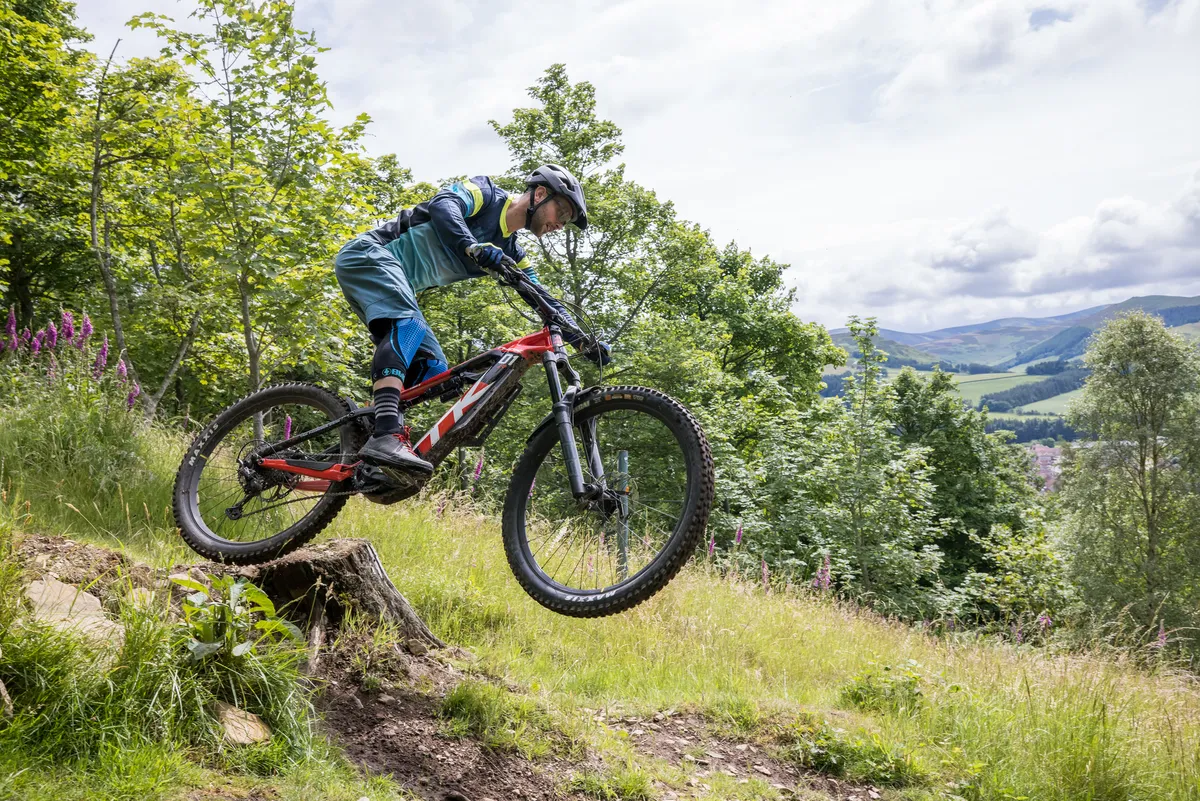
Conversely on the Yeti, in Eco and Trail modes, whether they were set to their stock assistance levels or had been adjusted to give more or less output, power felt a little lacklustre. There were some very steep sections, where I felt the gearing didn’t go quite low enough to comfortably spin to the top in anything but Turbo.
This made me wonder whether the 34t chainring could be swapped out for something smaller, although Yeti states its suspension system is only compatible with 34 teeth.
However, once I’d got used to the assistance levels and how the motor performed, I enjoyed riding the EP-8.
It’s hard to comment exactly why this was the case, but the EP-8 fitted to the Yeti 160E could have updated software installed compared to the Thok.
Yeti 160E T1 battery life

On a single charge with the bike set in 50 per cent assistance mode exclusively, I managed 2,145m of climbing over 48km and 3 hours 10 minutes of moving time.
This exceeded how much I eked out of the Thok and Santa Cruz Bullit, both managing only 1,755m in Eco over 39km and 3 hours, 20 minutes elapsed time (set to 30 per cent assistance) using the same 630Wh battery and EP-8 motor.
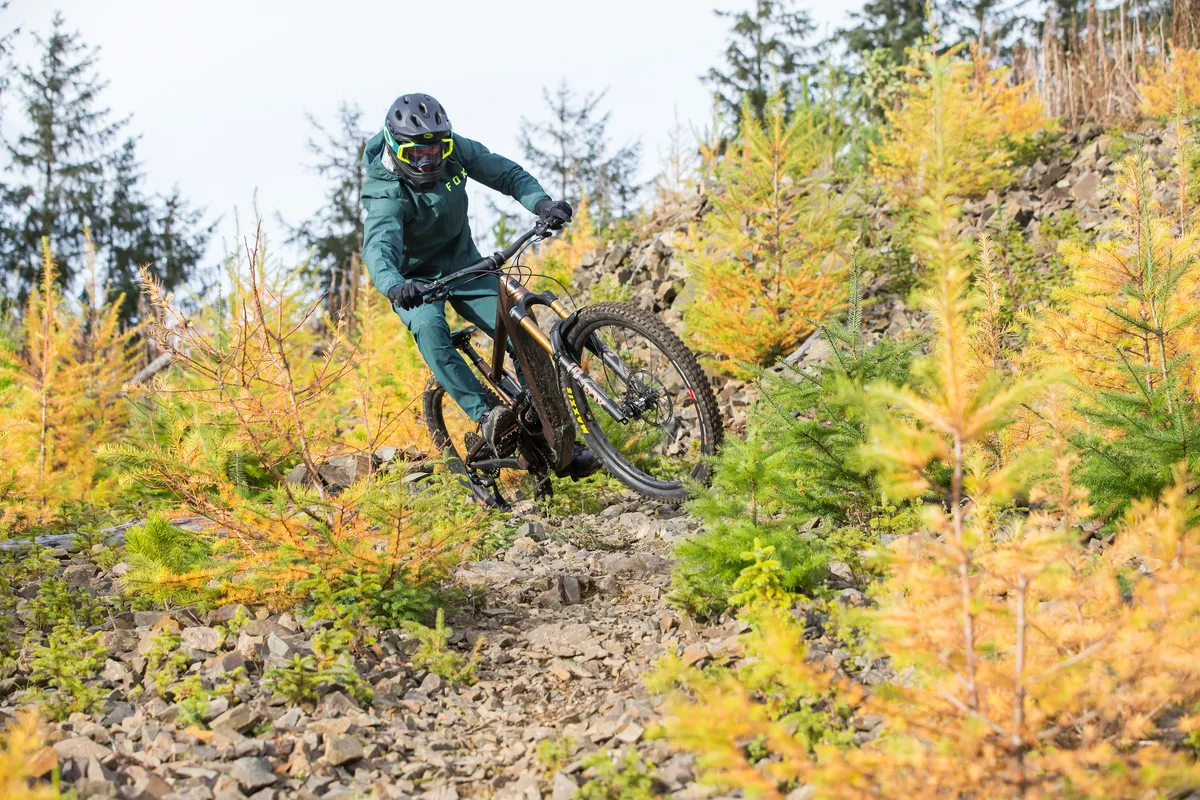
The differences in range highlight how factors such as the weather and temperature, trail conditions, plus others all influence how long an ebike’s battery can last.
Regardless, the 160E’s range was impressive and easily rivals the Specialized's motor and battery (700Wh), despite the 160E’s battery having 10 per cent less capacity (630Wh). Clearly, the EP-8 uses its battery more frugally than the Brose motor, too.
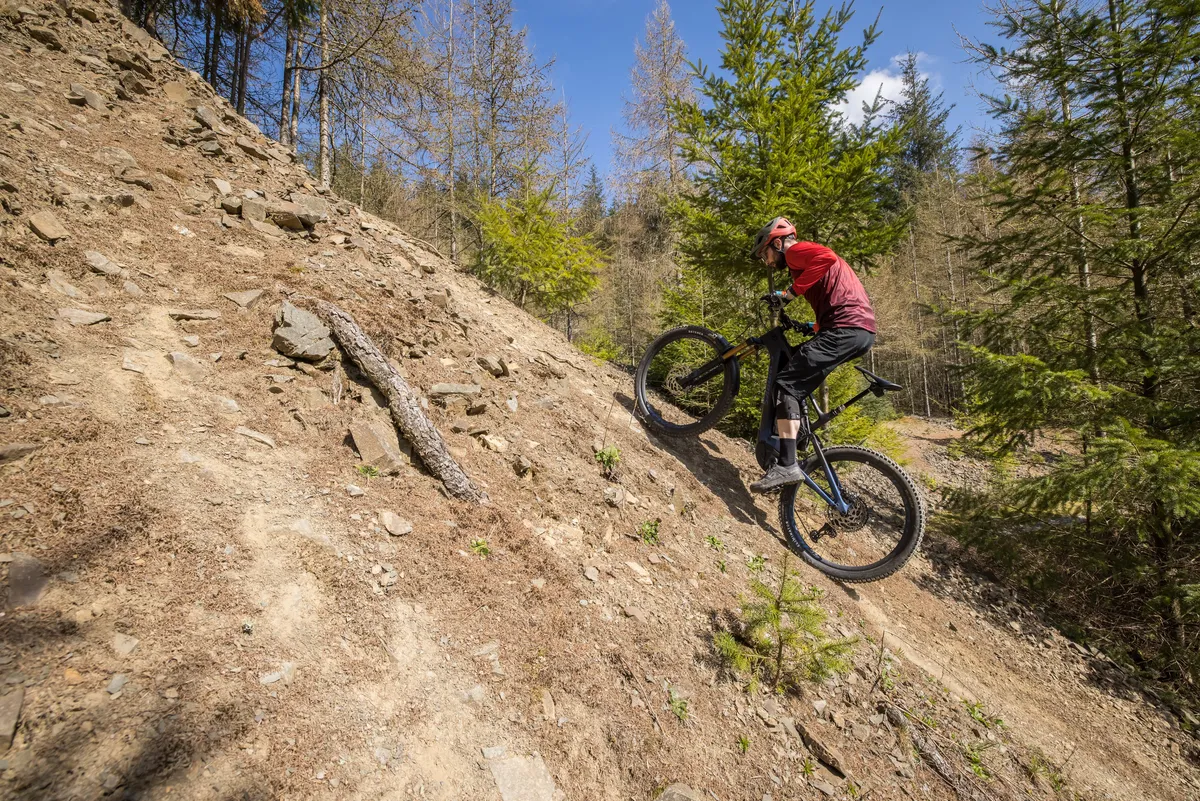
The five-bar battery charge display (where each chunk represents 20 per cent charge) is frustrating to use compared to the Brose’s one per cent increment display. It makes managing battery life harder than it should be and means some guess work is required to discern exactly how much charge is left.
It would be helpful if Shimano added the option for riders to display more accurate battery information.
2022 Yeti 160E T1 descending performance

Initially, the 160E felt low at the front thanks to its 625mm stack height and 20mm rise bar. On steeper or faster tracks, the front wheel was too easy to overload with weight, requiring an exaggerated counter-balancing motion towards the rear of the bike.
Fortunately, the steerer tube was long enough to accommodate 25mm of spacers under the stem to jack the front end up and I was able to confidently weight the front end without it feeling as if I was pivoting over the top of the handlebars.
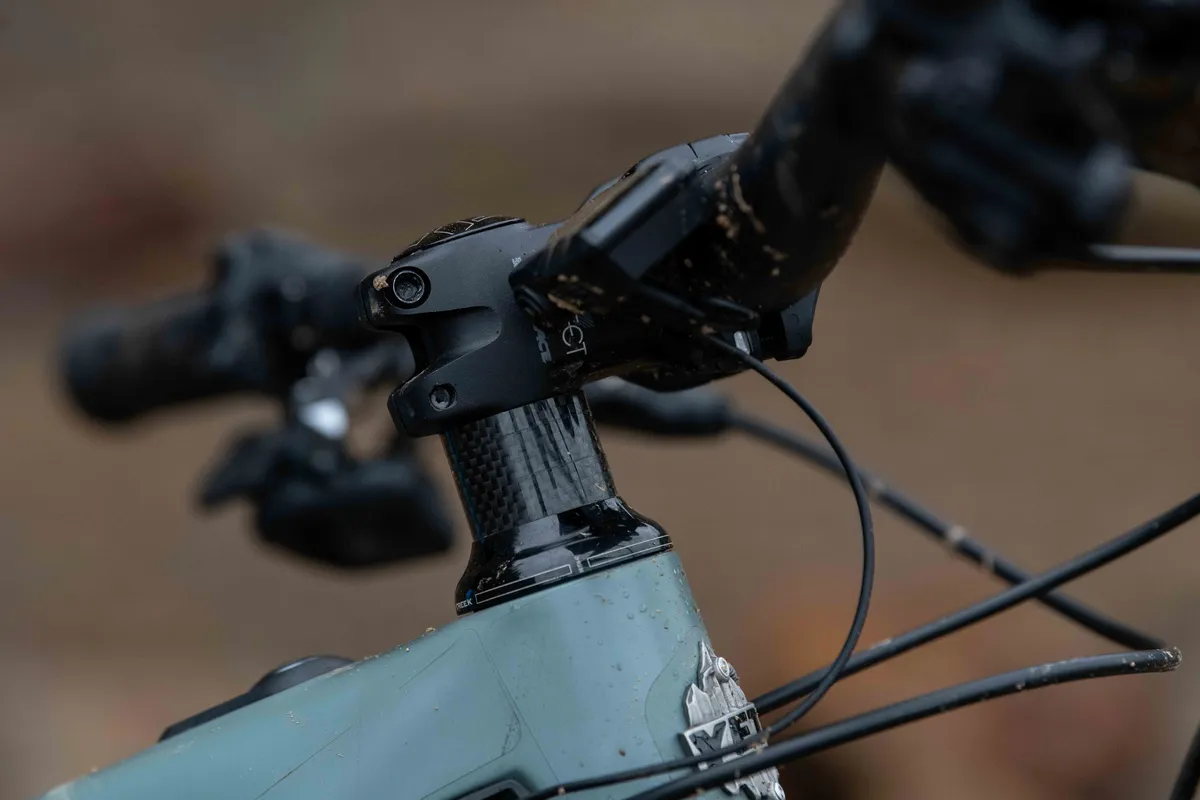
However, the factory-cut steerer tube meant the amount of adjustment available – to make the front end higher – was maxed out, and other people might prefer their bars to be higher still.
Because the bike relies on Yeti’s custom handlebar for the ebike controller and display cables, it isn’t easy to swap it out for a higher-rise version, and as far as I am aware, Yeti doesn’t currently offer different models of its ebike bar.
The perfect blend
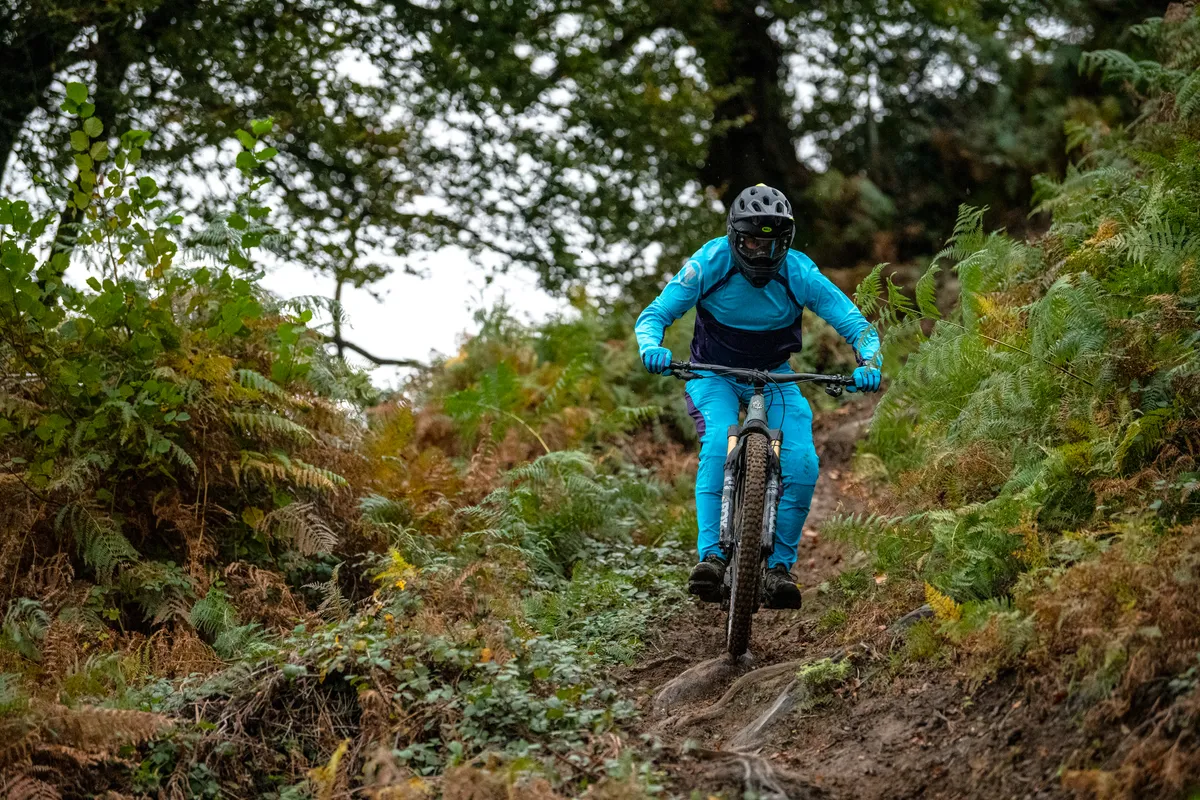
The 160E’s ride is dominated by the marvellously poppy suspension, which gives it a character unlike any other electric mountain bike I’ve ridden in recent times.
This is matched with almost implausible suppleness, creating the perfect ingredients for a bike that is grip-rich, but can also be picked up over roots and rocks, pumped through holes, and switch lines with incredible accuracy.
Its traits of soft and grippy but stable and poppy feel almost at odds with one another, and it’s unusual to ride a bike that behaves like this, but also weighs more than 23kg.
Because the rear end is so supportive, the 160E encourages active line choice down the trail, where the loading and unweighting of the bike makes it feel like you’re riding a rolling wave.
Pressing it into the ground generates grip ready for a direction change, and the loading up of the supportive suspension prepares it for the next rhythmical float over rough terrain.
As the suspension doesn’t devour its travel too quickly or easily, changing direction while the bike is loaded isn’t coupled with drastic chassis-upsetting changes in geometry and subsequent adjustments in body position.
It also meant I was able to lean over the back of the bike – something the steeper than preferred head tube angle encouraged – without the rear end sagging too far or wallowing into its mid-stroke.
Bottom-out resistance
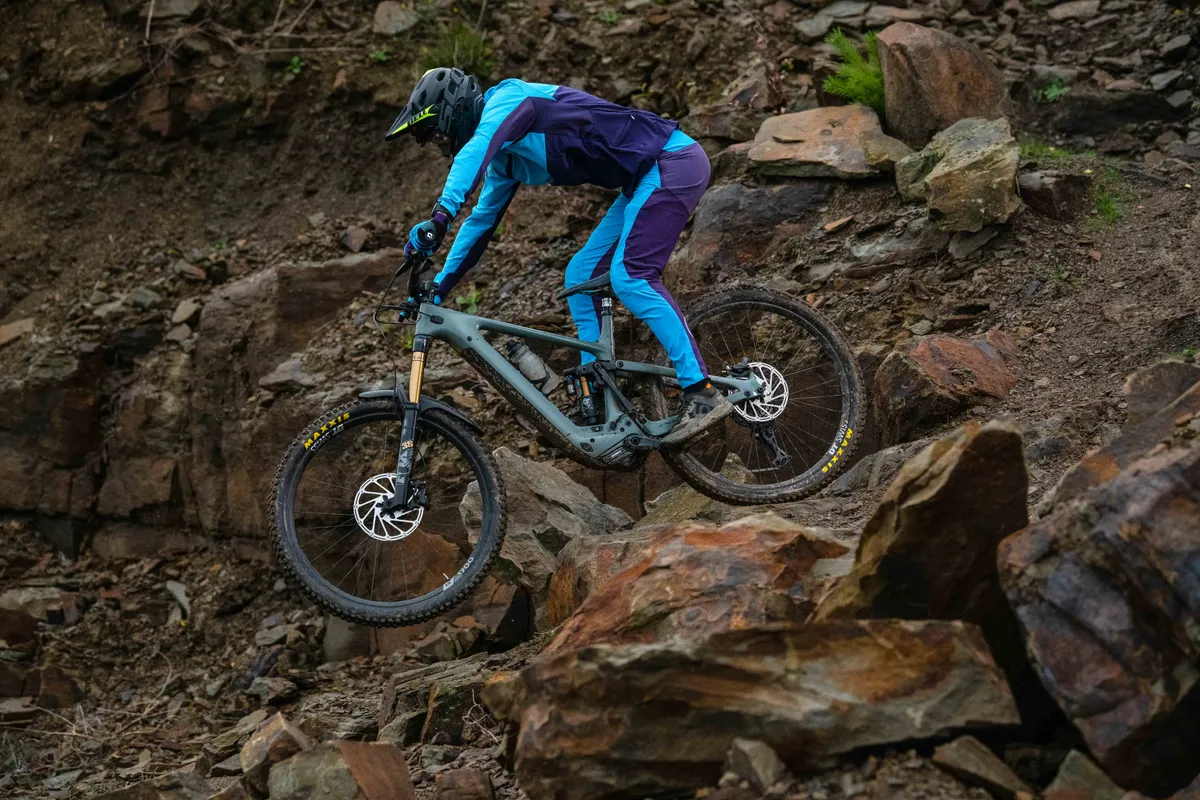
Bottom-out resistance is really impressive too, even in the middle 30 per cent setting.
This offered the best balance on most of the terrain I rode and remained my favoured setting for the duration of the test period.
On tracks with large drops to flat, I could have adjusted it to the 35 per cent position to increase bottom-out resistance, but the scarcity of this type of feature meant making the adjustment wasn’t worth it for the reduced use of full travel in other scenarios.
However, even in the 30 per cent setting, there were scenarios where the end-stroke ramp up was fractionally too much. Although the effects of this didn’t affect the way it rode negatively, it could impact the longevity of certain parts.
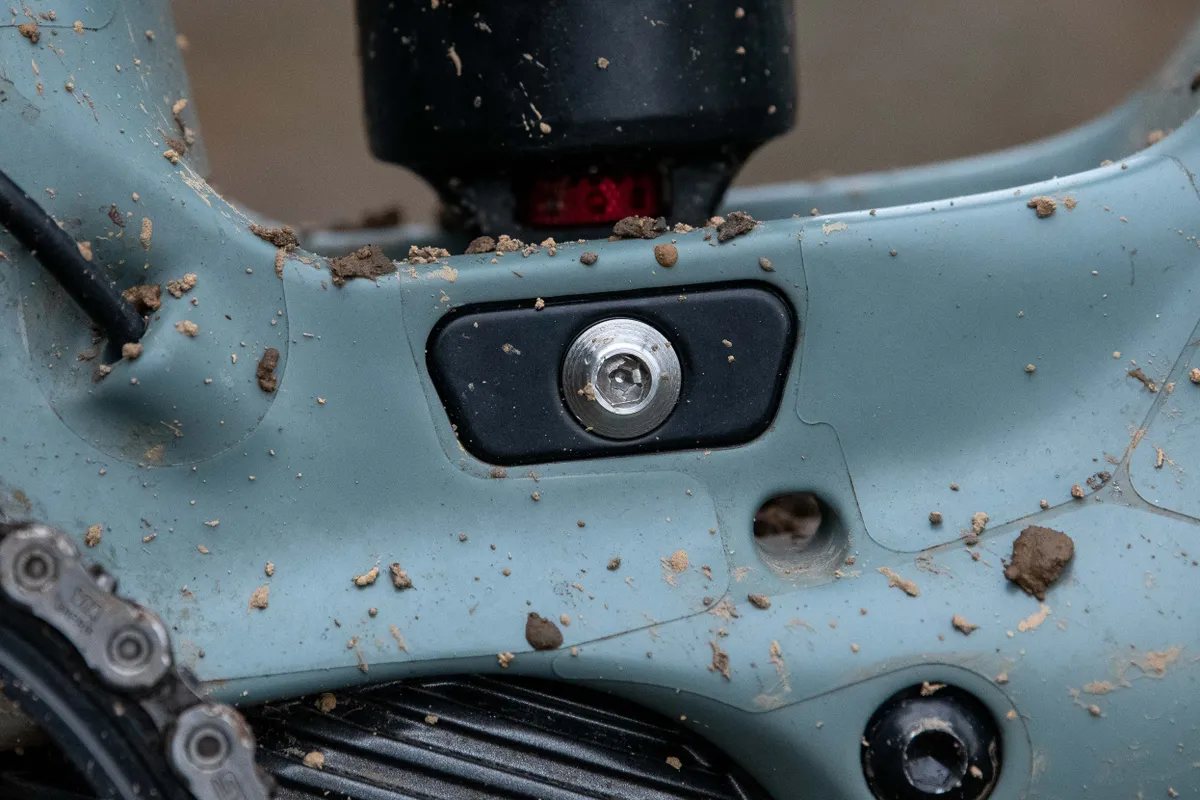
In situations where the bike was deep in its travel – such as riding through a deep, harsh compression while weighted for grip – and it needed to absorb another hit such as a root, rock or square-edge bump, the progressivity reduced the suspension’s ability to do so.
Those forces needed to be absorbed by another part of the bike, usually the tyres and wheels. Although the rims remained damage-free during my month-long test period, experience tells me that regularly encountering situations such as this leads to ripped tyres and dinged or buckled rims.

Fortunately, these hits weren’t transferred through the bike into my hands or feet in a way that reduced comfort and control, or tainted the way it rode.
The front and rear suspension were very well balanced, too. The fork and rear shock would use the same amount of travel out on the trail, enhancing the predictable and easily rideable qualities of the bike.
The full package
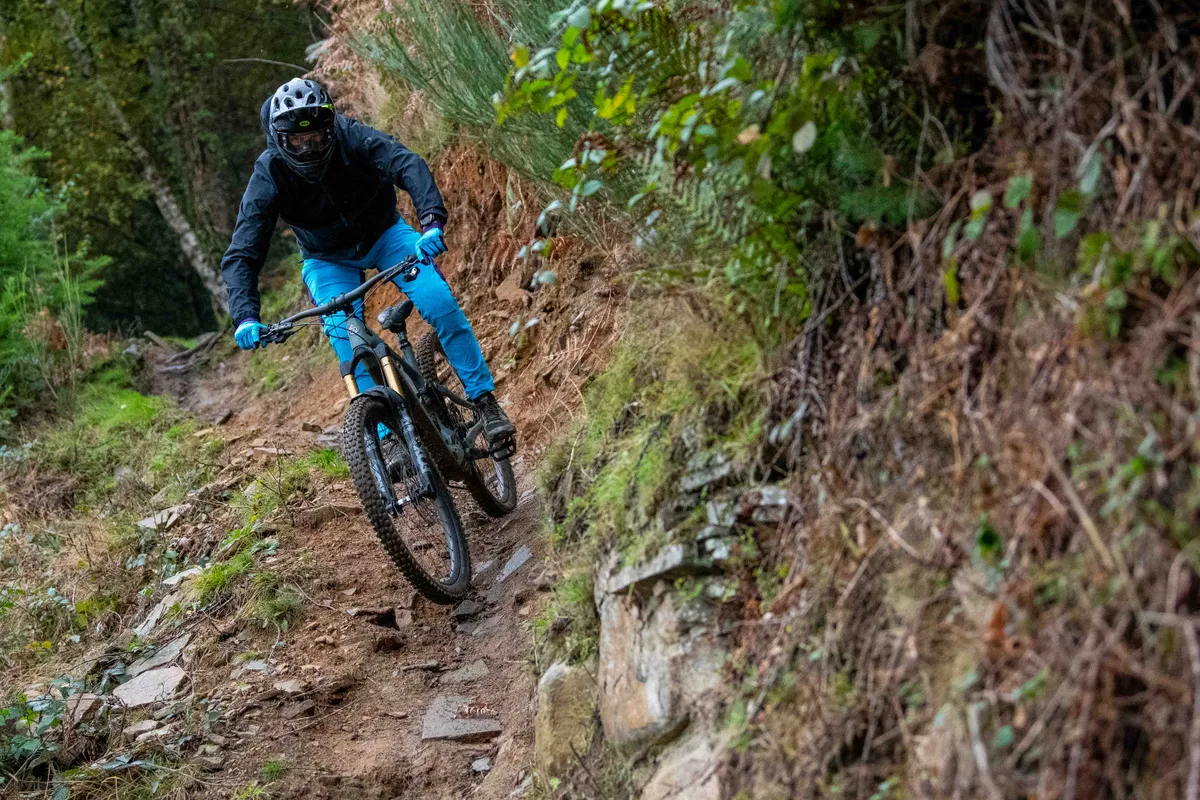
Combine that beautifully controlled suspension with its geometry, and the 160E’s individual traits come together to form an impressive, confidence-inspiring blend.
Despite the steeper-than-average head tube angle, the rest of the bike’s figures and its construction seem to make up for any potential shortcomings.
Out on the trail, it has truly incredible descending performance, where there’s a brilliant mix of frame rigidity for holding lines with serious accuracy, while remaining supple with a softness that means it doesn’t get bounced off-line.
It’s easy to control and ride, and impressively comfortable on rough trails, reducing fatigue.
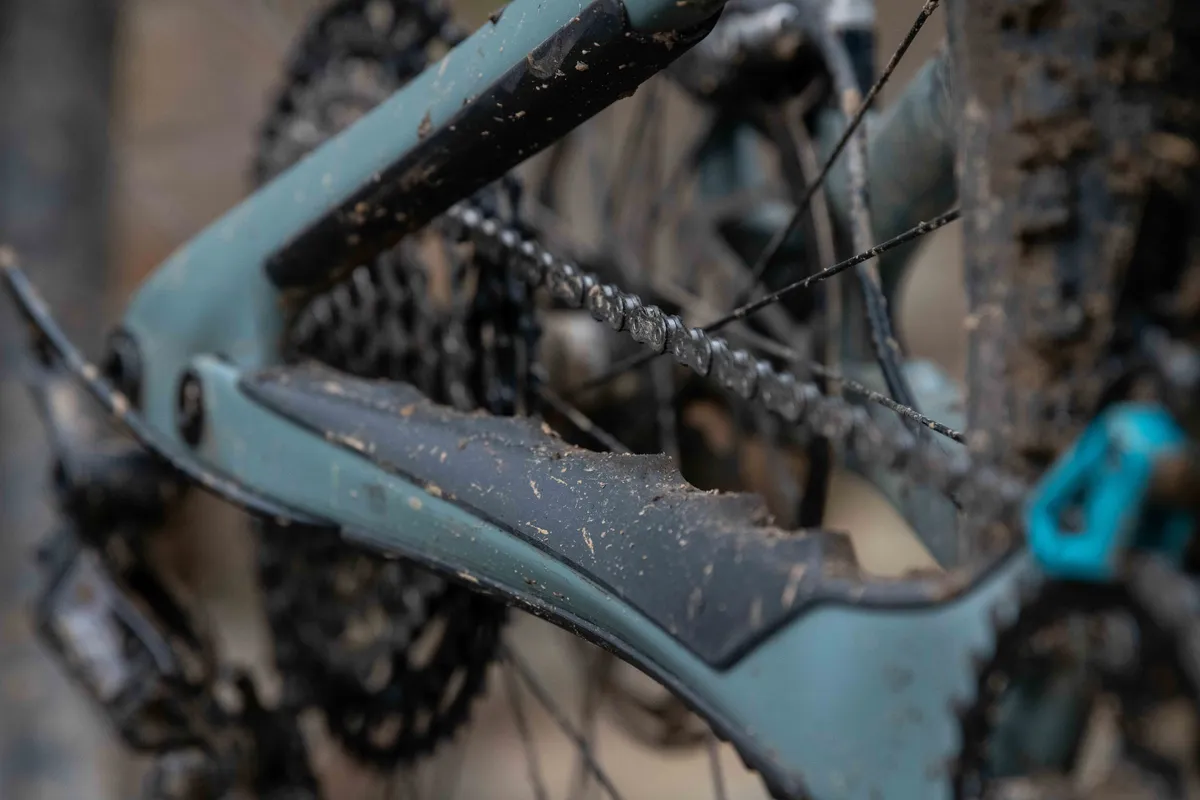
Thanks to this blend of characteristics produced by the suspension, frame and components, it’s predictable to ride hard, where hammering into the terrain to drive grip and choose lines is calm and consequence-free. The 160E helped me ride faster and with more commitment.
The calmness and predictability of the 160E ensured it was easy to feed grip into the tyres with weight shifts, by putting pressure through the chassis via the pedals and bars. This is a bike that sticks to its lines with confidence – it’s fun and rewarding to ride, especially when trails are rhythmical in their nature, with a flow that demands being light and then heavy over the varying terrain and through turns.
There’s also plenty of braking grip on tap and driving the bike into the ground made the tyres bite aggressively into the terrain.
This reduced the runaway train feeling some ebikes have, although it was still possible to overwhelm the Code brakes on prolonged descents, and begged the question why didn’t Yeti spec a 220mm rotor on the rear to match the front disc?
Heavyweight helpfulness
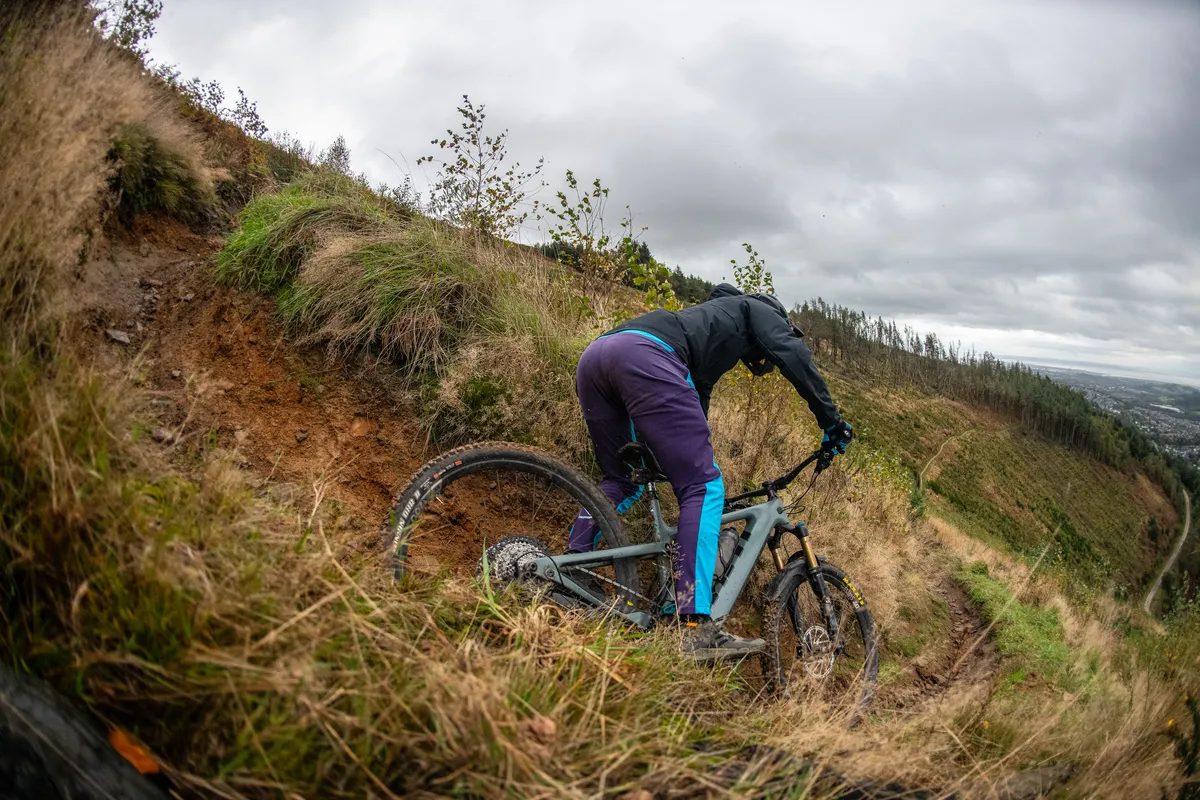
The Yeti’s super-smooth ride feel is not just thanks to its suspension, geometry and construction, but also down to its sprung versus unsprung mass ratio, where the main frame is significantly heavier than the swing arm. As a result, the suspension moves more on bumps, where the weight of the main frame gives the swing arm something to ‘push’ against.
This makes the bike feel incredibly stable on the trail, where there’s little seesawing (or yawing) over bumps, and the bars and bottom bracket remain uncannily level. My arms and legs were doing less work absorbing the impacts, with the bike isolating me more from the trail. Plenty of other ebikes also ride like this, thanks to their sprung-to-unsprung mass ratios.
Problems with Shimano’s EP-8 motor
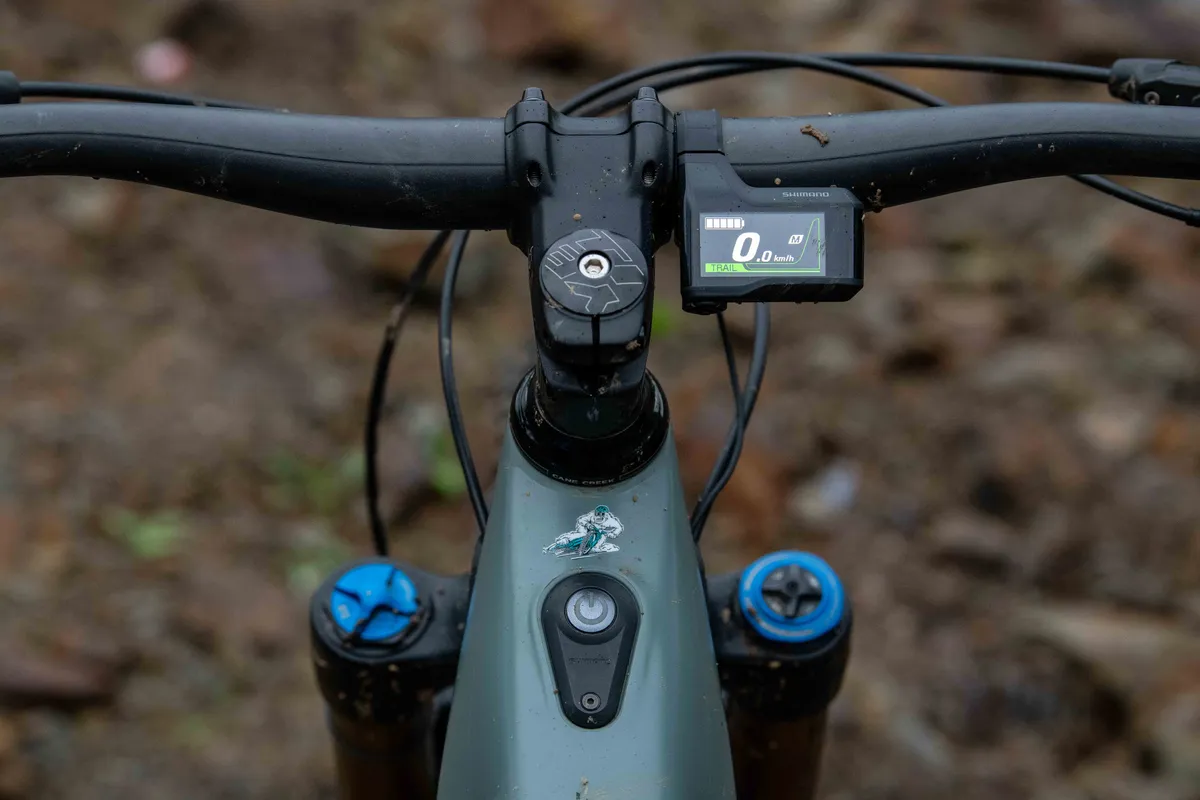
For the first time in my experience of testing Shimano’s EP-8 on multiple bikes, the motor bolted to the Yeti failed during the testing period, displaying an E010 error.
The error occurred on a wet ride with frequent puddles, but it wasn’t raining. These weren’t the wettest conditions I’d ridden the Yeti in, and I’ve ridden Shimano EP-8 bikes in even wetter conditions without problem.
What happened when the Shimano EP-8 stopped working?
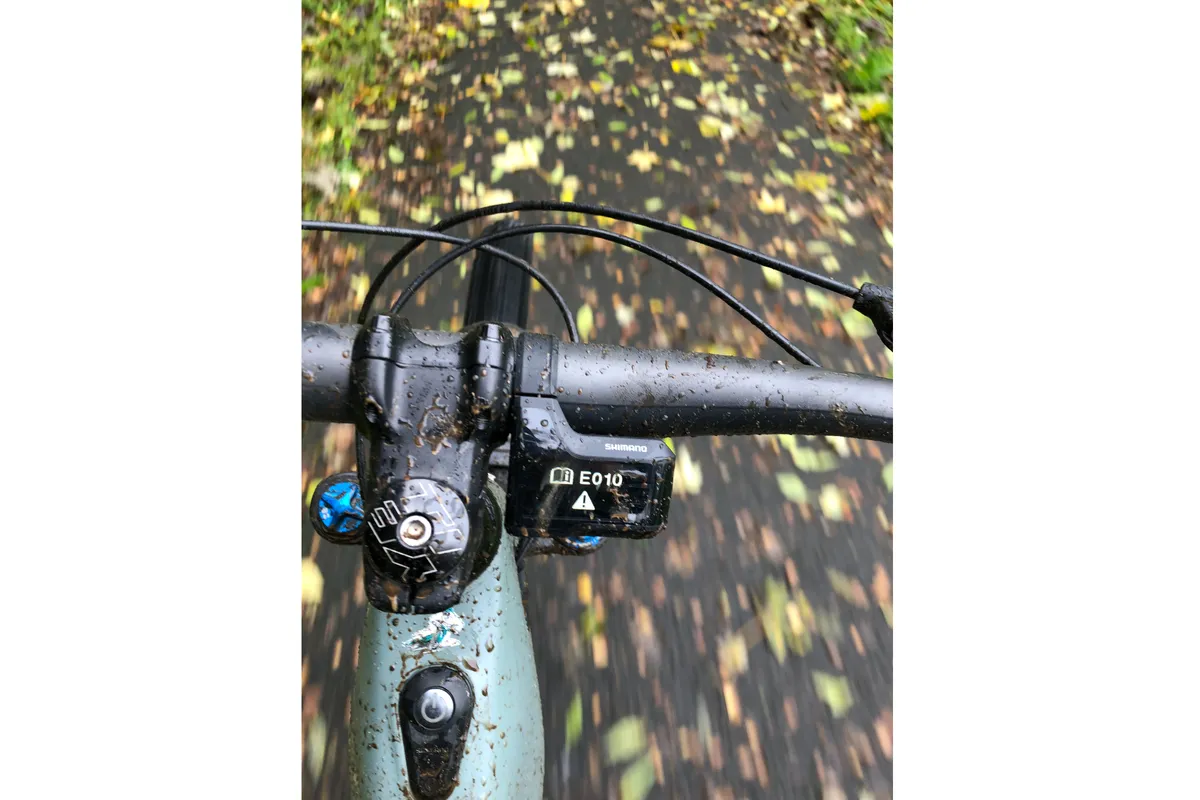
Symptoms came on quickly, when I was powering up a fire-road climb in Turbo mode, sitting on the speed limiter. The bike suddenly started kangarooing (akin to running out of fuel in a motor vehicle), where the power assist surged on and off for around 5 to 10 seconds, with the bar-mounted display showing corresponding changes in assistance on the graphic visualiser.
The motor then stopped providing assistance, and shortly after displayed the E010 error. Turning it off and on again didn’t clear the fault, and I had to pedal home from deep in Glentress forest without the motor’s assistance.
According to Shimano, the error code means “System error detected. Restrictions: No power assist while riding”.
What would a customer need to do to fix their bike?
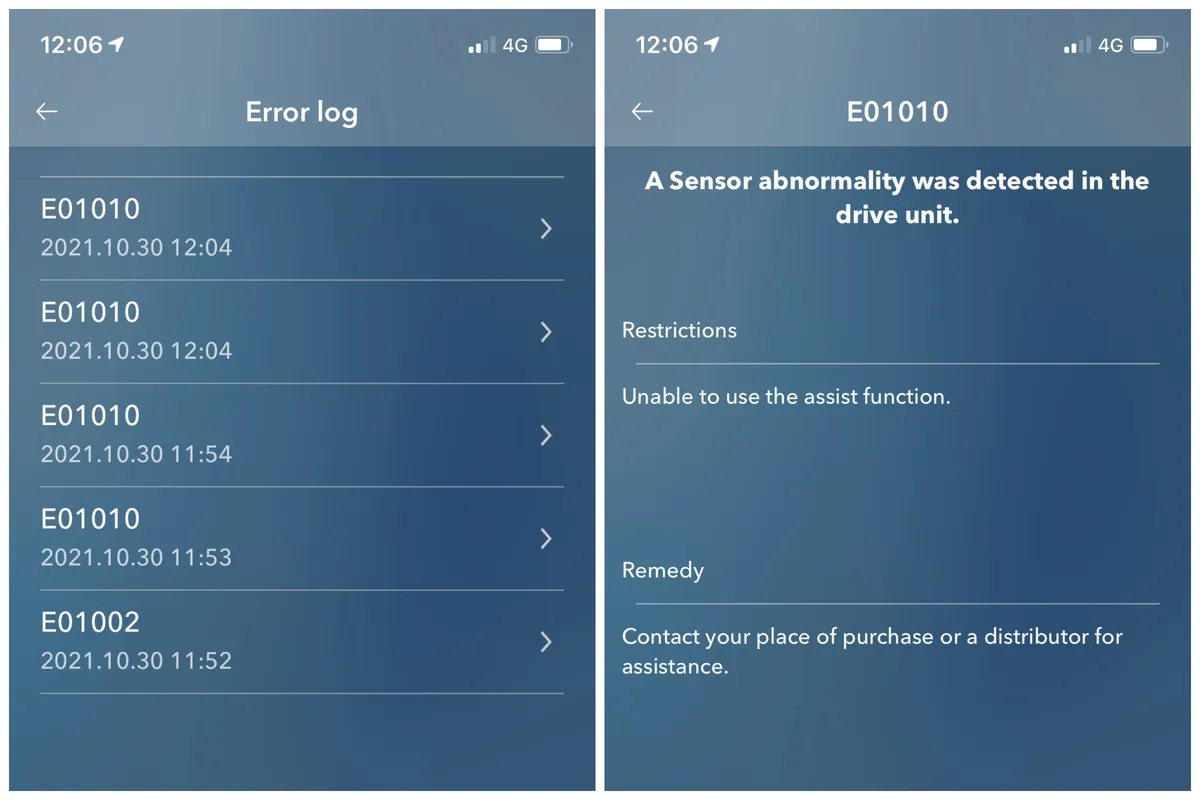
To begin troubleshooting, the bike needed to be connected to the E-Tube Project app for further diagnosis. If the app was unable to clear the fault, and if the motor was still unresponsive, then further investigation would be needed from either a Shimano service centre or the place of purchase.
I connected the bike to the app, but it wasn’t able to bring the motor back to life, and it instructed me to contact the place of purchase or a Shimano distributor for assistance.
If I was a consumer, I would have dropped the bike off at the place of purchase and the following steps would have happened behind the scenes, but for transparency, this is what occurred:
I got in touch with Silverfish UK, Yeti’s UK distributor, who put me in touch with Shimano UK to begin resolving the issue. Shimano UK advised me to take the bike to my local Shimano service centre, Tweed Valley Bikes in Innerleithen for further diagnostics.
I dropped the bike off with them, and the investigation process started.
Shimano’s investigation process revealed the drive unit was faulty, and that it required replacing.
In this instance, the faulty unit was covered under Shimano’s two-year warranty. Its replacement, plus the cost of having it replaced, would have been completed free of charge to the consumer.
Shimano UK issued the following statement to me about the motor failure and what a consumer should expect if this happened to them:
“Consumer handling for Shimano STEPS product family.
Obviously, there is a huge step in technology here (if you’ll pardon the pun), and components to consider that never previously existed on your bike.
Hopefully you spoke to your dealer upon receipt of your e-bike and know all about their operation and aftercare. However, I would always take the time to familiarise yourself with anything that is new, making use of the information that is widely shared by Shimano on what you have purchased. I would probably start here…
https://www.shimano-steps.com/e-bikes/europe/en
…and if you had further questions, I would direct you back through our dealer network of local bike shops and Shimano Service Centres.
Like every Shimano product that went before it, we treat these components in exactly the same way.
Should a question arise, or there be a product fault claim, we would always direct you to our global network of Shimano dealers, and in most cases the original place of purchase.
[Should you have made a purchase through a distance seller or from a direct to market brand we also have a network of Shimano Service Centres who are specialists in the field of Shimano and would be an advised point of contact for you to discuss what should happen next.]
See the Shimano Service Centre locator here…
https://www.shimanoservicecenter.com/uk/dealer-locator
We would expect that upon visiting your dealer, an intake of your bike would take place, and an estimate of the necessary corrective actions with a timescale/cost. Please see the below link to Shimano’s warranty terms.
https://bike.shimano.com/en-EU/information/warranty.html
It really is that simple.”
- Shimano UK
Yeti also supplied me with a statement on what a consumer should do or expect if this happened to their bike.
“Shimano is a world leader in e-Bike motor and battery technology with extensive global support, therefore Yeti chose them as their partner for the new 160E. As with any advanced and complex system – things can occasionally go wrong. In the very rare instances where there is an issue, the Yeti and Shimano UK retail network is well placed to help get issues resolved quickly, and the rider back on their bike as soon as possible.
That is what happened in your case after you experienced some issues; the bike was taken to a local retailer and Shimano were able to promptly repair the Steps system and get it back to full working order.
With regards to warranty, it is worth pointing out that all Yeti frames, including the 160E, come fully backed by a no quibble, no BS lifetime frame warranty.”
- Silverfish UK
2022 Yeti 160E T1 bottom line

Clearly, it is disappointing the Shimano EP-8 motor failed, though this can happen to any electrical or mechanical device or component. Given Shimano’s warranty would cover the cost of a replacement motor, and this is the first EP-8 I’ve had fail on me across multiple test bikes, I’ve focused my verdict on the 160E’s performance, not a specific Shimano part used across countless electric mountain bikes.
If a consumer was required to fork out a substantial amount of cash (€999 according to Commencal’s website) for a new drive unit, my verdict and score would change significantly given how long I rode the bike for, and its initial purchase price, but Shimano UK has assured me this wouldn’t be the case.
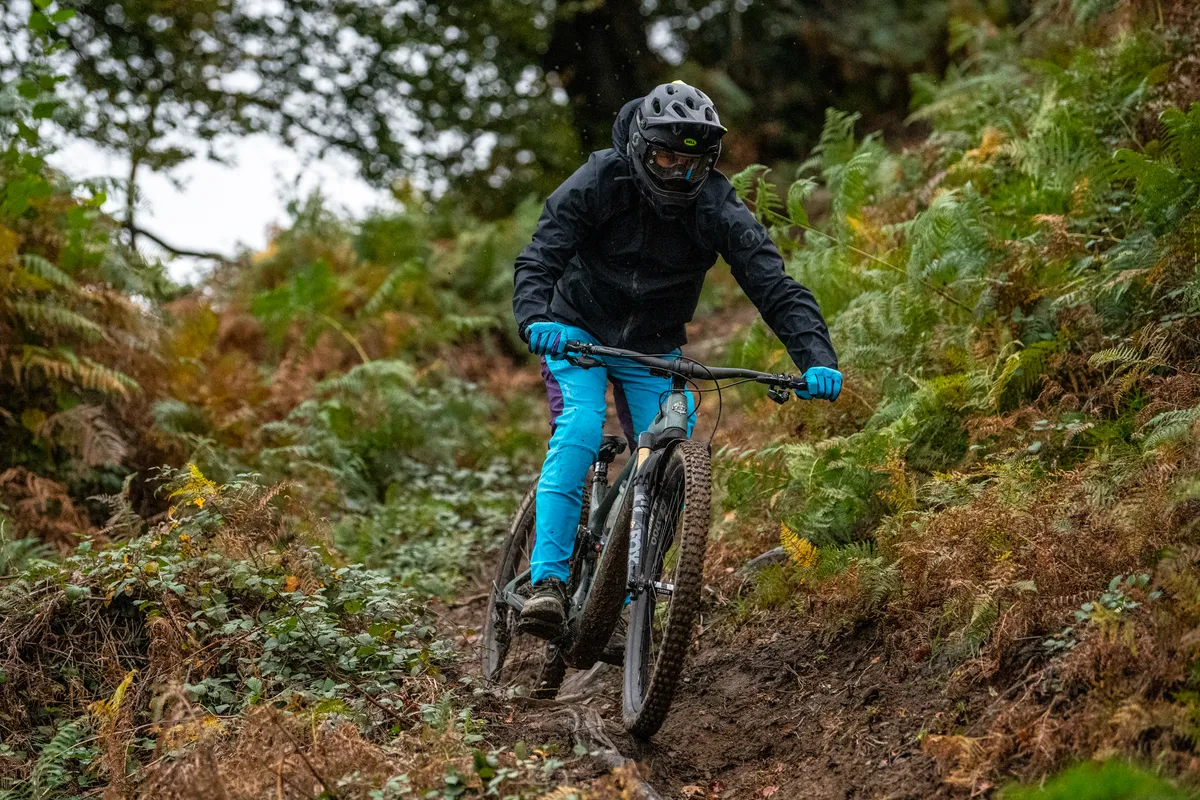
There’s no denying just how fast and capable the 160E is. Its suspension, geometry, chassis and spec combine to create a masterfully enjoyable, controllable and predictable bike to ride on the harshest, gnarliest terrain out there.
In that sense, it achieves Yeti’s aims of being a bike for the true enduro racer who’s looking for outright performance. This performance will benefit the average Joe, too, and anyone who rides the 160E will have an absolute blast.
Product
| Brand | yeti |
| Price | 13790.00 EUR,11899.00 GBP,12700.00 USD |
| br_whatWeTested | Yeti 160E T1 |
| Weight | 23.4500, KILOGRAM (Large) - Size large, without pedals |
Features
| Fork | Fox Factory 38 GRIP2 |
| br_stem | Race Face Turbine R 50mm |
| br_chain | Shimano XT M8100 |
| br_frame | Yeti TURQ series carbon fibre |
| br_motor | Shimano EP-8 |
| Tyres | Maxxis Assegai 3C MaxxTerra EXO+ 29x2.5in (f), Maxxis Minion DHRII 3C MaxxTerra DoubleDown 29x2.4in (r) |
| br_brakes | SRAM Code RSC |
| br_cranks | Shimano EM900 160mm, 34t |
| br_saddle | WTB Silverado Custom |
| br_wheels | DT Swiss EX1700 |
| br_headset | Cane Creek 110 |
| br_shifter | Shimano XT M8100 |
| br_cassette | Shimano XT M8100 10-51t |
| br_seatpost | RockShox Reverb AXS |
| br_gripsTape | ODI Elite Pro |
| br_handlebar | Yeti Carbon 35x800mm |
| br_rearShock | Fox Factory Float X2 |
| br_bottomBracket | Shimano |
| br_availableSizes | Small, medium, large, extra-large |
| br_rearDerailleur | Shimano XT M8100 |
| Features | Sixfinity suspension, progression adjustment |

